#they also go into depth about how they funded his movie projects and how they got fucked around basically
Explore tagged Tumblr posts
Text
I think what hbomberguy missed out on his video was the way James Somerton also dismissed ace people's oppression by claiming that they didn't 'go through conversion therapy' or apparently 'suffered as much as gay men'.
So here's a video I want to share by the Ace Couple going into depth about the whole thing and how James reacted when called out... spoilers, he didn't react well. I just hope by James' mistakes he and other people can learn something and grow.
youtube
#mentions of sa racial violence and acephobic + homophobic slurs in the video so be careful#they also go into depth about how they funded his movie projects and how they got fucked around basically#i think maybe hbomber missed this or maybe the video was too long already so no hate towards him at all#tw conversion therapy#tw aphobia#tw acephobia#lgbt+#lgbt#queer#asexual#tw harrassment#james somerton#hbomberguy#Youtube
51 notes
·
View notes
Note
BAM SURPRISE you are the head writer at Disney or whatever (the entire corporation for all their companies and movies, not just Disney animated) for one week and anything that you do during that time cannot be changed/altered later. What are you doing
Oh geez
Okay, besides torching all the sin-affirming stuff they do—
I would mandate that no more Live Action Remakes be made. Like, ever. I would cancel all upcoming sequels. I would force only Walt Disney Animation Studios and Pixar Studios to work on new animated films coming out—no utilizing the studio in Vancouver or outsourcing the work to AI or Japan or anywhere outside the U.S.
I would do that in the hopes that the animators who understand our specific culture would be forced to meet the challenges posed by new projects, instead of taking computer-generated-AI shortcuts to solving hard-art problems. And, when they make a movie that takes inspiration from other cultures, it forces them to learn about those cultures, themselves. Then, when they make movies, their unique American-in-Fill-in-the-Blank-Culture perspective adds depth, flavor, and my favorite thing, earnestness, to the design of the movie.
Next! I would hire Chris Sanders back. I would pay him literally anything he wanted. Probably by selling all our holdings in Marvel, because Marvel is dead as a doornail.
With that cash flow I would also LOWER THE PRICES TO GET INTO DISNEY WORLD AND DISNEY LAND. The prices get lowered. I don’t care. I don’t care. I don’t care if the whole company goes belly-up because I did that; I would drop the prices considerably to get into the parks. And to get Resort Packages. And then I’m jacking up the prices for the overseas parks.
Know what else I would do? Fix the Yeti in Expedition Everest, add the Hatbox Ghost into the Haunted Mansion, and blitz social media telling everyone about it. While I’m there I’ll make a post about how we’re destroying Genie+ and the Lightning Lanes. Utterly gone. Nobody gets to purchase cut-in-line time slots. Everybody waits in line together. Because guess what, forcing the normal-people line to completely halt while you let traffic from the gave-up-my-firstborn-to-purchase-a-faster-line-experience line go first every three minutes is CAUSING the wait times FOR BOTH to get LONGER, tricking people into purchasing “faster” line experiences that are actually still horrifyingly slow, and ruining the already-overpriced day for everybody involved.
Ahem.
Meanwhile, we’re getting that money back, because I’m putting Chris Sanders on a brand new project; he’s going to pitch me two ideas. One idea is all his own, it can be anything he wants. The other has to be an adaptation of The Firebird fairy tale. But he can be as liberal as he wants with the details, like he was for Beauty & the Beast.
He gets to direct his own, obviously, but since directing two projects would be really hard, I would bring in Roger Allen and Rob Minkoff to handle The Firebird.
Once we have the money, I’m funding four new projects in Disney World. The first is, Pizza Planet is becoming the new restaurant at Disney Springs.

The second is, the Rock n Rollercoaster is getting replaced by Phineas & Ferb’s coaster—just in time for the new season to come out on Disney+!

The third is; Avatar: The Way of Water-themed Resort which connects to the park, but guests may only cross over into the theme park during special After-Hours, when regular guests have had to leave because it’s closed. But it would be over the water, and have its own water park.
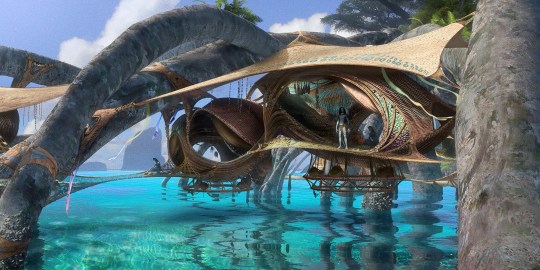
There are those indestructible glass windows making holes in the floor and the sides, and the rooms are all suspended over real water (with carefully-constructed foliage so that even though it feels open to the air like in the movie you actually have complete privacy, nobody can see into the rooms. And we’ll add curtains for the faint of heart, whatever) The windows in the floor double as screens which you can turn off or on; if the screens are on, a randomized animated loop fools the eye so that every once in a while, Avatar characters and marine life swim by or interact with guests.
Fourth thing in Disney World: additions to all the lands they’ve hobbled together in the last twenty years.
For example, New Fantasyland gets a Tangled ride where you’re following Rapunzel’s hair trail through the environments of the movie, and you and Flynn Rider are trying to catch up to her; but at certain crossroads the people in the vehicle can choose between multiple paths for your ride vehicle to travel down. This way, you and your party can be racing one another, so there’s an element of competition like there is in Buzz Lightyear Space Ranger Spin.
Also! Galaxy’s Edge gets walk-around droids, two new hangout-style open-air restaurants, and an elaborate playground area made up of of nets, rope courses, and simple alien animatronics like you’re exploring a Resistance Base that was constructed by Ewoks.
Dinoland U.S.A. Is scrapped (except for the Dinosur Ride which is relocated) to make room for The Pridelands. You heard me. You thought I was going to say Zootopia, but no, that’s not jungly enough for Animal Kingdom.
The Pridelands has another the-most-elaborate-playground-in-the-world section, which is huge and sprawly, and full of things like fake tunnels which connect to the hollow skulls of elephants in an elephant-graveyard section, with screens made to look like windows that peer down into the geyser-bubbling lair of Scar. And of course there’s a Pride Rock, but it’s made like Rapunzel’s tower, so it looks far away in perspective, and occasionally an animatronic Zazu hops out onto the ledge, looks around, and hops away, or Simba prowls out, roars, and backs up out of sight again. Like a giant incredible cuckoo clock.
There are three rides to start with. One is a zany Timon-and-Pumbaa ride/game where you’re basically doing the Space-Ranger-Spin thing, looking for grubs. Another is a rollercoaster called “Escape the Stampede” and you’re basically hurtling along as if you’re galloping just ahead of the wildebeest in the gorge.

The third is a walkthrough of the events of the film, but with Avatar-level-advanced animatronics and hyenas come lurching out from behind things to snap at you.
The Pridelands has two restaurants; one is counter-service and it’s called “Timon & Pumbaa’s Grub Hub” and it’s all pasta bars, and Mac-n-cheese, so you can pretend you’re slurping up grubs if you’re a kid. The other is a reservation-only restaurant made to look like the beautiful forest Timon & Pumbaa live in, with built-in waterfall features and a ceiling that changes color and lighting effects to look like a starry sky or a dazzling sunrise depending on the time of day. It’s very atmospheric and the idea is to go on dates there. There’s also live African music.
And we’ll relocate the Festival of the Lion King here, too.
I’d also make a video game that is open-world and online-multiplayer, like Destiny, BUT it’s an elaborate retro-futuristic world with its own story based on Tomorrowland. The story would be impacted by what the players all around the world choose to do in-majority, and I’ll have three or four different routes it can go—but the main thrust of the game’s long, ongoing plot is a metaphor for the hard, passionate work of being innovative versus the dangers of cutting corners to make a profit in the name of ��progress.”
For our Live-Action Department, they’re going to be working on a new series of Westerns based loosely on Big Thunder Mountain. It will be a trilogy, and it will star Matt Lanter as the hero, villain-character played by Chris Pratt, and Tim Allen (Tim Allen is Matt Lanter’s estranged father.) When they’re done with that they get to make a Space Mountain movie starring Letitia Wright. That’s what our Live Action Department gets to work on—original dramas based, if anything, on our original theme park attractions that nobody else in the world has.
And for our television studio, Tom Bancroft and his brother Tony are hired to make an animated series called “Escape Schism” and it’s about a young girl who discovers she has the ability to escape her dystopian-future world by jumping through television screens into movies. Each movie is a loose parody of iconic movies in the real world. The catch is, she can only stay in those movie-worlds for one day, and she can only take one object from the movie-world back into the real world after each visit. Other characters include the little brother she’s always trying to protect from the dystopia of their reality, and her older sister who works as a detective for the evil corporation that’s functioning as the government.
It’s lighthearted, it gets great views.
Then I’d hire @doverstar to make a series on Disney+ as a sequel to Lilo & Stitch: the Series. It can be Stitch & Ani.
Then I’d put the guy who did The Lion Guard in charge of Disney Junior, spearheading two new shows—one is a show about Robin Hood and Maid Marion’s life before the events of the animated movie, and the other is an original show called “Gift Shop” and it’s about a gift-shop owner who is actually a fairy godmother, and has to figure out the exact-right gift to give the fairy tale characters who stop by every once in a while. But it’s told from the perspective of her pet owl, Dusty.
Aaaand finally I’d completely destroy the Haunted Mansion movie in favor of a new, three-part television-film, (like the ones they do on SyFy) told from the perspective of the Groundskeeper. In this treatment, a young man named Kyle is terrified of really making the most of his life because of a fear of failure. He made one big mistake and it cost the family their ancestral home when he was a senior in college, and he can’t get over it. He becomes groundskeeper of the Haunted Mansion because of the exorbitant amount of money offered to do the job, thinking it can help him buy back the family house. Instead, he encounters the Hatbox Ghost—who enlists the new Groundskeeper’s help adventuring to break the control Constance Hatchaway has over the 999 Haunts living there. The Hatbox Ghost and she used to be in love. Kyle has to help them solve that in order to free himself from the position as Groundskeeper—but he thinks there’s something the Hatbox Ghost isn’t telling him.
While we’re at it, I’d remake Wish and The Rise of Skywalker. Because nobody can undo what I’m doing but I can undo what they did, right?
#Disney#wish#rise of Skywalker#the haunted mansion#Disney world#Disneyland#Disney+#glen keane#tangled#rides#Disney fan#theme park idas#Matt Lanter#Christ Pratt#Tim Allen
65 notes
·
View notes
Text
Lost Legends
Okay so I read Lost Legends: The Rise of Flynn Rider and general thoughts? It was cute and fun, and I have gripes here and there but I can still recommend it. I don't want to compare it to WOWM because it's like apples and oranges but Lost Legends wins points for me by actually acknowledging the TTS storyline and characters, even though it's kinda brief and not quite as... entertaining.
And before I go into the in-depth spoiler review I'll jot down a few thoughts here: there's a lot to be said about tie-in media and 'canon', but where I think it becomes contentious is where two pieces contradict each other, and whether those contradictions necessitate a canonical hierarchy or cancel something out completely. And the reason I'm bringing this up is because while LL borrows TTS lore it also contradicts it? which is. ironic.
but i'll get into that. Spoilers ahead
Basic Summary of The Plot
Our story starts at the Dark Kingdom, with a short prologue. It's all stuff we already know from the series: King Edmund tries to grab the moonstone, his wife dies, Eugene gets sent away for his own safety. What's funny is that Ms Queen still doesn't get a name, but her Lady in Waiting/Handmaiden gets a name (Maeve), and it's Maeve who really drops the ball on dropping Eugene off at an orphanage instead of raising him as Prince Horace. Go girl give us nothing
And from here the LL timeline begins, as Eugene and Arnie are now twelve year olds (I think?) in an orphanage in Corona. Which is the first contradiction to 'canon' but shelve that thought for now. Eugene and Arnie are good little boys but they're getting too old to keep hanging around and the orphanage needs money for the evil Tax Man, so they decide they'll go off into the world and send some money back when they're rich off their famous adventuring. What happens instead is that The Baron's circus rolls into town (yes that Baron) and Eugene and Arnie decide to try their luck signing up for that gig.
To prove themselves to the Baron, Flynn and Lance have to perform a hazing ritual a heist. The heist is literally just to buy a key from the Weasel but it plays out as this huge dramatic thing with a guard chase which is eternally funny to me because two kids walk into a bar, buy a key and then leave, and it's treated like fucking ocean's eleven. The Stabbingtons try to betray them (those guys are here too) but Flynn and Lance outsmart them, beginning a rivalry for the ages. Also, the pub thugs are all part of the Baron's circus crew. Don't think about it too much.
Anyway, as this has all been going down, Eugene is really interested in getting to talk to this guy with a tattoo of (what we as the audience know is) the brotherhood symbol, which Eugene recognises from the note left with him as a baby. He wants to talk to this dude in the hopes he'll get a clue about who his parents are, but this dude keeps eluding him. He also hasn't had a chance to tell Lance about this yet, so when Lance finds out about it he assumes Eugene only tried to rope him into the circus so he could find his parents and ditch him. Cue an ongoing silent treatment.
Eugene eventually does talk to this guy and he learns that the Brotherhood symbol is from the Dark Kingdom but the Dark Kingdom is gone so he shouldn't bother looking for it. Bummer. And now the Baron is planning a huge heist of the reward money for the Lost Princess' return, and Eugene is getting cold feet. He's been okay with a little bit of thievery so far but this feels like too much for him, and he's not okay with pulling it off but Lance still won't talk to him.
As the plan unfolds, Lance and Eugene reconcile and then they work together to betray the Baron and return the stolen treasure that they stole back to the King and Queen. They get caught by the Baron, escape, then get caught by the guards, but it's okay because they're presented to the King and Queen and when Eugene explains that they felt really sorry about it and promise not to do it again they're let go. And so the story ends on a high note.
My Thots™
Okay so here are the thoughts
Canon Compliance?
The obvious takeaway here is that this story offers you a beautiful pie in the form of the characters you know and love and the established lore, then shoves the pie in your face with things like "Eugene already knows the Dark Kingdom and the Moonstone exist but he never brings this up" and "Eugene betrays the Baron in a very significant way but somehow they'll make up and he and Stalyan will get engaged". Which means that if the integrity of the series is important to you, you'll probably just mentally cross out Eugene knowing about the Brohood/DK/Moonstone.
And imo that's fine! My own approach to this story is a kind of general 'if it works it works, if it doesn't I'll leave it' thing to work my own headcanons around. Because there's a lot of fun things to pluck from, like a new ex-Brotherhood member and other characters that could pop up from Eugene's past and other worldbuilding details.
The Story
The story was pretty short and obviously very tailored towards a younger audience, but it still felt kind of... slow? Mostly because nothing particularly exciting is happening until the big heist and even that feels pretty underwhelming. And of course I don't expect a story like this to be particularly complex and can appreciate its simplicity, but I felt like if it had been longer there could have been more twists to keep things interesting.
For example, the Baron is set up as a character not unlike Gothel, who lavishes praise upon the boys and goes on about how they're 'family' but is obviously just manipulating them and would throw them to the wolves in a heartbeat. Eugene underestimates just how criminal the Baron is, but at no point in the story does the doubt we have in the Baron's sincerity ever amount to anything- Eugene only turns against him because he has a morality crisis, which I'll get to in a minute.
Misc. Thoughts
Okay so one thing I thought was really cute was that each chapter has a little 'quote' from a Flynnigan Rider book, and I wrote them all down so if you've read this far and want me to post those separately lemme know. Anyway I just thought it was a very cute touch.
An honourable mention goes to every time Stalyan shows up, she doesn't really do anything in the story yet still is somehow the only character holding the brain cell. Rapunzel gets an indirect cameo by Lance and Eugene stumbling upon her tower and going "Whoa that's Crazy. Anyway. " which is amazing, and Cassandra even gets a little mention by the Captain! And to answer the question nobody asked, there's a chameleon running around Corona because she's an escapee from the circus, and Pascal's mom's name is Amélie!
Characters - okay really just Eugene
Eugene/Flynn is the title character of the book and we get the story exclusively from his POV, so there isn't a lot to say about Lance. On the one hand while I can acknowledge that this is a story about Flynn, not Lance, there's a few choices that feel like a missed opportunity at best given that this book really was an opportunity to explore Lance's character in a way the series never really does.
And it feels extra egregious when the plot demands conflict between Eugene and Lance, because while the emotion between them is engaging when it's happening, at other times it just feels like a convenient way to shove Lance offscreen again. (As a side note, as contrived as the conflict is these are also two twelve year old boys so. Can't blame em too much).
Also, Eugene coming up with the name "Lance Strongbow" on Lance's behalf while he's unconscious is one of those backstory things I'm not going to be acknowledging, thank you.
The Robin Hood Dilemma
Something I touched on after reading What Once Was Mine is that Eugene's characterisation prior to the movie isn't something writers seem to really like... dealing with. And it kind of makes sense that the author received a lot of characterisation notes from Chris Sonnenburg, because little Flynn does feel very similar to the Eugene we know; only the Eugene we know is an adult man who has since grown out of his Flynn Rider persona. But the Flynn Rider persona he needed to grow out of isn't something that ought to be cast aside entirely!! Stop being cowards!!
Taking a step back, the whole premise of the book is kind of a paradox- because Eugene needs to become Flynn Rider before he can learn to embrace his authentic self, but Flynn Rider isn't hero material, he isn't a good guy, he's not the right protagonist for a story for kids. So what we get isn't Flynn Rider, it's really just Eugene trying on a new name. That works for the beginning of the story, because he is just Eugene trying on a new name, but he doesn't grow into it.
At the beginning of the story, Eugene is an orphan in a poor but still functional orphanage run by a kind old lady, and he is surrounded by nice little boys. Eugene is motivated to leave and get a job by a desire to send funds back to the orphanage, and when he joins the Baron's circus he's taken aback to learn he's among thieves. Here's where I thought: okay, this might get interesting. We might be getting a G-rated 'angel falls from heaven' story about Eugene being morally corrupted by the Baron, of learning that the world outside is tough and he needs to look out for himself first and foremost-
but no. The Baron shares his plan to steal the reward money for the Lost Princess, because all the people he's surrounded himself with are already criminals who don't give a shit, but Eugene thinks that this is going too far! What about that poor lost princess who people need an incentive to search for? (he's like, projecting about his own parent issues which is fair, but still). And so the story ends with Eugene turning on the Baron to return the money to the "right" people (aka the king and queen of a kingdom?? okay) but he takes a single golden egg for himself so he can send it to the orphanage.
Which is all sweet and nice but. He still has to become Flynn Rider, asshole extraordinaire. He still has to lose his morals to the point where he'd take an inexperienced young woman to a pub that he, in this book, recognises is a dangerous place in the hopes that he can ditch her. He still has to go and become a wanted thief and rejoin the Baron and then ditch Stalyan on their wedding night.
The reason I'm going on about this so much is that the appeal of Eugene to me is that he is this good guy who wants to be a better person for the people he loves, but that means recognising that he has behaviour he needs to change, and his development is meaningful for that. Watering him down to a righteous Robin Hood hero does him a disservice.
The Real Villain Was Capitalism All Along
I will not elaborate nor should I
22 notes
·
View notes
Note
how would you do a percy jackson adaptaion?
okay, so I know this is a controversial opinion right off the bat: I really don’t think it should be an animated series.
A large part of the appeal of the series is that it’s a fantasy series set very very firmly in reality. Literally, apart from the camps, you could go to every location hit in the books. Riordan mentions specific streets, buildings and landmarks, and that was cool when I first read them. I remember being a kid and waiting for him to set a scene in a place near where I lived! I remember trips to New York and being able to envision an epic war happening in the streets. So I think any adaption needs to be live action just to keep that same feeling alive, while I’m not knocking on animation, I just feel like taking the story out of real life would make it loose a little of the charm. Like, the scene where Manhattan is completely frozen in time? It would be haunting to see that in real life, but I feel like it would be less impactful if it didn’t…you know…look real? The series should be done in a way that makes you truly feel like you could just turn a corner and walk straight into a snake woman going about her day.
Now: another large part of the appeal of the series is how funny it is, but a lot of that…is Percy’s inner monologue. He doesn’t actually voice most of it, there was even a book where Annabeth described him as being quiet. So, I think the best way to work around this: make it Interview With A Demigod.
Imagine it’s got an interview with a vampire-esque setup- and this even works because within the riordanverse, the books canonically exist because Percy sat down with a ‘camp scribe’ and had his quests recorded. So, like, this isn’t even entirely out of left field. But just imagine, a college-aged, maybe a little older Percy, I can see it so clearly in my head, he’s wearing a sweatshirt that at first glance looks like it says NYU but a trained eye will see it actually says NRU for a camp jupiter easter egg, he’s sitting in some dinky little diner (maybe it can even be a monster donut or something with a clever greek myth related name) with a guy who’s recording the conversation on some old-ass tape recorder that keeps acting up but they can’t record on a phone because of the whole technology thing. Every now and then it’ll cut back to them to get some great Percy thoughts out there. They open with older Percy saying the ‘look, I didn’t wanna be a halfblood’ and then explaining where he was when the whole mess started. Once he get’s to “was I a troubled kid?” the screen fades from older Percy to 12 year old Percy getting in a fight with Nancy and her gang, and the voice over says the ‘Yeah, you could say that’ part as we see him get threatened by the principal to behave on the field trip. Boom, we’ve got an opening. Lowkey….I’m seeing Jordan Fisher as older Percy, but I’m not 100% married to the idea.
And before anyone tries to argue that showing an older Percy would spoil he’s not gonna die in last olympian- like, reading the books, we all knew he wasn’t going to die. It was a first person narrative and he was consistently speaking in past tense lmao like we Knew he was gonna make it. We still enjoyed the series. It won’t ruin anything.
I want part of the score of the adaptation to be instrumental versions of songs from the musical, I think that could be a sweet nod to that team.
They really need to nail camp halfblood. I know that goes without saying, but in order to keep the pacing of the story decent we can’t spend as much time falling in love with it like we got to with the book. The book is like, 24 chapters and the quest starts at chapter 12- for a movie or tv show, that’s just gonna feel like it’s dragging. So, the insanity of the camp needs to smack you in the face right away, and then it needs to endear itself to the viewers quickly after that. Don’t try to ease the viewers (or Percy) into the mythology is real thing, rip it off like a bandaid. He’s on his way to meet Chiron and Mr. D for the first time and even if he’s not comprehending what he’s seeing, there’s nature spirits and harpies all around going about their day. Hestia waves at him and then disappears into the flames. Hecate kids can be seen casting a spell on the porch of the Hermes cabin. The Stolls are seen pranking some Aphrodite kids. He sees someone surely die on the climbing wall but then you hear a faint ‘I’m okay!’. The Apollo kids put a rhyming curse on another cabin. Pure chaos all before he gets the ‘so, gods are real’ speech. And then after that…show how warm Luke is to him at the cabin and at dinner. Show the kids all goofing off at the campfire and really make it clear that they’re children. Show the strawberry fields rolling in the wind and Percy sitting on the beach. The whole couple weeks where he’s searching for powers and learning greek and latin with Annabeth can be a montage. Make it clear how hurt and scared he is when he finds out he needs to leave.
It needs to really get you feeling how Percy’s feeling, every laugh, every tear, every moment of fear or confusion needs to shine clear through. Like…think of Spider-Man Homecoming, the Washington monument scene. All things considered, it’s not the most high-stakes scene we’ve ever seen in that franchise, and when it cuts to the kids in the elevator, they’re worried but not quite freaking out, but that scene feels very high stress to watch because the movie is good at getting the viewers to feel what Peter feels. A Percy Jackson adaptation needs a touch like that, because Percy’s a very emotional kid and that’s what a lot of the scenes hinge on.
Lowkey- I’d love it if the casts of both the previous movies and the musical had cameos or bit parts (the movie cast did Nothing Wrong, it was the rest of that team). It’d be hilarious to see, like, Jake Abel as the owner of the poodle, or Logan Lerman as Older Percy and the reporter’s waiter that keeps trying to get in on the conversation, or Brandon T. Jackson as a satyr who’s still stuck grooving out in the Lotus Hotel and Casino. Kristen Stokes as a nature spirit, Chris as one of the ghosts stuck in the waiting room of DOA Records, just like any of those casts having small parts would be fun and sweet.
There should be a lot of easter eggs for the bigger riordanverse. Promotions in the background for the new Tristan McLean movie. Gabe’s got a true crime documentary about the missing Grace children playing during his poker game. Mr. D is reading a paper about Rachel Dare’s father’s newest project. At some point while they’re still in New York they pass the Kane family’s mansion or whatever it was called. Annabeth keeps a picture of little her and Magnus on her nightstand. The barest of hints about the Triumvirate. Seeing kids in camp jupiter gear in some background shots, just out of notice of our main characters but implying the camps are going through similar problems (BITCH….if we got a titan’s curse adaptation…and we had a shot of Thalia in the foreground….but in the background we saw a blond boy in purple with a golden sword….well I would simply loose my Goddamn mind).
And show us how easily the mist lets things blend in, too- like, everyone thinks ‘Monster Donuts’ is just a normal chain, it’s just on an average street block, but if Percy looks through the window he can see who’s behind the counter. Show someone swindling some guys in a park and you have to look twice to realize he’s a gegeines. Like…how people are still trying to find all the background ghosts in haunting of hill house. I would LOVE to see a bunch of background monsters and mythical beings just going about their day as much as the mortals are while the gang’s questing.
The effects need to be fun. The whole story needs to be fun, but one weird thing about the past movies are that like…in their attempt to make it gritty, none of the fantastical things happening on screen actually felt that exciting. We need bright colors and interesting choices, consistently cool action shots, a liveliness that makes you feel like you’re in the center of the action. I have absolutely no doubt Disney easily has enough funds to pull off great effects.
The characters need to be….in character lmao. Annabeth needs to be cocky and bratty with the skill set to justify it. Percy needs to be a sweetheart who pretends to be hardened because that’s what people assume he’s like. Grover needs to have dry humor and a Too Old For This Shit attitude whenever percabeth start bickering. Luke needs to be nice and friendly but in a specific way that you can look back after the betrayal and see he was trying to groom everyone. Sally needs to be loving, protective and strong. Chiron needs to feel defeated and determined at the same time. Mr. D needs to….be Stanley Tucci lmao
Also, I’d love if the adaptation could expand more on things that got brushed along in the books- Percy and Beckendorf’s friendship, Silena and Clarisse’s dynamic, make Nico’s crush on Percy a little more obvious, give Rachel some more development. One thing that haunts me about the books is Sally never found out that Gabe hit Percy. Absolutely they don’t need to make the abuse explicit, but I also personally feel like a lot of Percy’s mindsets throughout the series are somewhat a result of Gabe, and I’d like if that got, you know, acknowledged. Maybe in the scene where he figures out Gabe abuses Sally he could say ‘does he hit you too?’ or something to that effect. They could also go more into detail about Annabeth’s family, give Zoe some more depth….like the possibilities I’m screaming.
Okay this is already long and I’m getting tired but I can so clearly see a great adaptation in my mind….Disney please come through….It’s what we deserve….
2K notes
·
View notes
Text
On revisiting Mothra vs. Godzilla (1964)
Mothra vs. Godzilla is an interesting film to say the least. On the surface it looks like nothing special, if anything you could call it an example of how Japanese science fiction films were stagnating only a decade after Godzilla (1954), considering this film barely does anything new, just aping material that was already handled by its two predecessors: Mothra (1961) and King Kong vs. Godzilla (1962). But somehow it’s become one of the most beloved entries in the series and something of a gold standard for everything that came after.
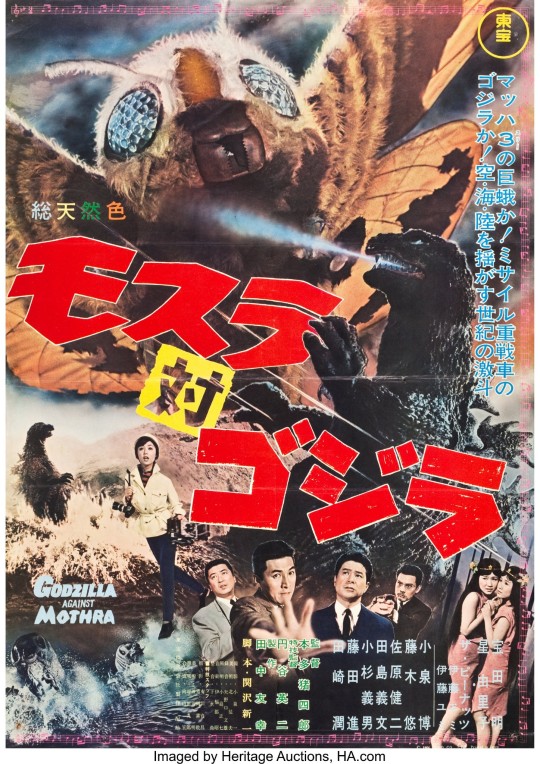
Mothra vs. Godzilla opens with a title credit sequence over a hurricane, with Godzilla’s theme from 1962 transitioning into an instrumental version of Mothra’s theme. The hurricane has caused property damage along the Japanese coast, but most notable is the washing ashore of a giant egg. We soon get introduced to Ichiro, a news reporter, Junko, a news photographer, and Dr. Miura, the leader of a scientific team called in to study the egg, who serve as our three main three heroes for this story. The egg is bought by Happy Enterprises, headed by a Mr. Kumayama, who is in turn financially backed by a younger Mr. Torahata, who plan to turn the area surrounding the egg into an amusement park. They and the three leads are both confronted by Mothra’s twin priestess fairies from Infant Island about returning the egg (the current adult Mothra is nearing the end of her life, and the egg secures Mothra’s legacy), and the efforts to retrieve it are also squashed, forcing the fairies and the indigenous people of Infant Island to turn their backs on the outside world. When Godzilla appears, having also been caught up in the hurricane and thrust onto the mainland, he immediately goes onto another rampage, and it seems the best option is to ask Mothra for help (personally I find it humorous that there needs to be some reason for monsters to fight in these early films given they’d eventually go at it on instinct). Some arguing is done but the fairies and Infant Islanders agree in return for the possibility of a better world to be built. Both Kumayama and Torahata are killed in Godzilla’s attacks, and the monster seemingly can’t be stopped, as even the adult Mothra succumbs to battle, before the newly hatched larvae from the egg eventually stop Godzilla, and all seemingly returns to normal, in a cautiously optimistic way, as the protagonists have vowed to make a world better for everyone.
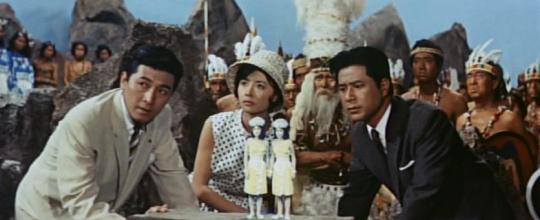
Mothra vs. Godzilla switches from the intense anti-commercialism satire of King Kong vs. Godzilla to some more general anti-capitalist themes. Near the opening when the damage of the hurricane is being documented by Ichiro and Junko, and unnamed capitalist protests about such possible news coverage as it could damage public opinion on an industrial project being built there. Later the same capitalist protests about the protagonists returning to test the area for radiation (as Godzilla is buried in the general vicinity and is contaminating the soil). There’s some inherent ridiculousness that’s openly stated about Kumayama buying the egg in general, but the cost is 1,224,560 yen (i.e. the logic is since a chicken egg costs 8 yen, and the giant egg is approximately 153,820 times larger, it’s a fair price). It’s explained “[the egg is] not private property, the public can watch it incubate for an admission fee.” A musical cue used in the series to hint at some under-the-surface tension and dread is used in this film when we discover that the egg’s incubator has been built and is already operational. Kumayama later stiffs the fishing village who brought the egg to shore out of the money he owes them, only to later on in the film be scalped by his superior Torahata (the two of them turning on each forces Torahata to shoot Kumayama, and in turn Torahata has wasted too much time before Godzilla destroys the hotel they’re in). Torahata is explained to have originally been some trust fund kid to some larger businessman before heading up his own endeavors. When the public discovers that it’s Mothra’s egg and it will not be returned, Kumayama effortlessly throws a PR stunt to counteract.

Functionally it’s a repeat of the plot from the first Mothra film, only here it’s Mothra’s egg and not the twin fairies that have not been kidnapped. I feel as if everything works smoother here as this film definitely has more weight to the proceedings and isn’t nearly as theatrical; the villian in Mothra, Clark Nelson, is often times a bit too exaggerated. (There’s something to be said about how Kumayama and Torahata have zero concern about provoking the wrath of Mothra considering she partly destroyed Tokyo and NYC in the previous film in the effort to get her fairies back; I guess it’s more accurate than capitalists just giving up possible investments.) I’ve seen some fans vouch for Mothra as anti-colonialist story but this film allows concepts such as that much more room to breathe given how the Infant Islanders have actual agency in the story, turning down the possibility of Mothra fighting Godzilla on behalf of Japan, whereas in the previous film they didn’t have much of anything to do given Mothra immediately goes on the attack upon discovery that the fairies were kidnapped.


The rather dense first 30 minutes of the film gives way to the reveal that Godzilla was also thrust ashore by the hurricane, and buried underground in the process, before reawakening. The entire film shifts into a mode of immediate urgency, as everyone now has to confront Godzilla. A lot of Godzilla’s scenes are far more detached than what else the film has to offer, as we’re following mostly nameless crowds fleeing and evacuating and JSDF officials trying to handle the situation. Once again it resembles the previous film, which had all the main characters more closely associated with King Kong. This film spends a much more notable amount of time showcasing military strategies being implemented against Godzilla with tanks and land mines and air strikes and giant electrocuted nets being thrown at him. I think it’s this film that fully established that while Godzilla could take a beating, the character is functionally indestructible, as nothing leaves any lasting damage.
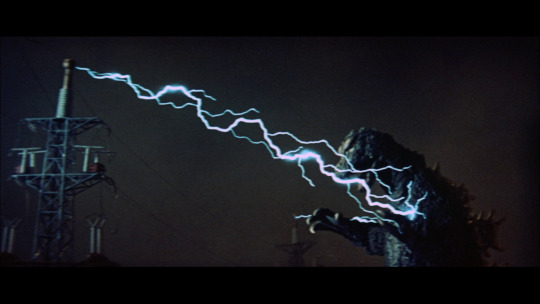
Even though this film isn’t as upfront with the nuclear text as the first Godzilla film (which openly compared the coming of Godzilla to the atomic bomb attacks and brought up Godzilla being born out of hydrogen bomb tests as the most likely origin), it’s still the only other entry in the Showa series aside from that first film which brings it up in any meaningful capacity. Initial news reports call Godzilla “the atomic monster”, and when our protagonists first ask for Mothra’s help because of the attacks, the Infant Island chief shoots back with, “it’s your fault for playing with the devil fire!” Both on a narrative and thematic level, Godzilla and the age of nuclear warfare are one and the same, and everyone from Kumayama/Torahata to any number of offscreen civilians to the people of Infant Island to even Mothra must contend with Godzilla; a deadly force that threatens everyone. Godzilla’s characterization in this matches with the first film more so than the previous two; Godzilla Raids Again doesn’t have much interesting to say given it’s a cash-in sequel, and the explicitly comedic tone of King Kong vs. Godzilla makes him out to be much more jovial than expected, taking delight in dishing out death and destruction. (An added detail in this film is the subtle inquiry that Godzilla is like a natural disaster, you can only move out of the way in the same capacity that you can’t physically fight a tsunami or a hurricane. This was an element of the first film with Godzilla’s first landing being obscured by a hurricane or the electrical towers set up outside Tokyo resembling sand bags defending against a flood.) But this film is the only sequel of the Showa era to maintain Godzilla in a purely threatening, antagonistic role.

The decision to feature both Mothra and Godzilla in a single film does produce more interesting results than having done so with King Kong. King Kong vs. Godzilla only really happened because Kong, in the real world, was the only extremely notable giant monster of the movies prior to Godzilla, and this limitation extends into the film with how the characters remarked over how their individual rampages were like a ratings battle, with constant “who’s going to win?” fights over the stronger of the two. There’s much more thematic depth with this entry, even on immediate visual level; Mothra is quite dainty and gentle compared to how dark and brutal Godzilla is. (Kong was blown up from approximately 20 feet to 45 meters to fight Godzilla for that film, and this film does so in turn. Mothra was absolutely massive in the first film with a wingspan of 250 meters, she’s been shrunk to 135 for this film. Whether it’s succumbing to radiation or just a natural part of Mothra’s life cycle is never openly mentioned.) The first Mothra film made mention of how nuclear testing occurred near Infant Island because no one knew an indigenous population lived there, and upon seeing it, both the characters and the audience discover a lush paradise that has somehow survived the radioactive fallout. This film stands in stark contrast; when the protagonists land on Infant Island, we discover it’s become a desolate graveyard, with only a hidden oasis being what sustains the local population. It’s not just that the egg was stolen, the Infant Islanders are initially non-compliant because their home has been destroyed. (For narrative purposes, Ichiro, Junko, and Miura function as representatives for the outside world, and are confronted about the atomic age despite them, you know, being Japanese. It works in context of the rest of the series wherein nuclear warfare isn’t blamed on any single country and is viewed as something that threatens the human race equally regardless of nationality.) Bringing in Godzilla as the overarching threat thematically completes the mythos surrounding Mothra. Mothra has the upper hand during the entire initial fight, what with her being able to fly and Godzilla being a slow lumbering animal, but one hit of Godzilla’s atomic breath is all it takes to finish her off.
Director Ishiro Honda has mentioned that the driving thesis across all his films (except maybe Matango) is the quest for peace amongst people, considering Honda embraced pacificism following WWII. Mothra vs. Godzilla is possibly the least subtle about this, with the scene where Junko makes a statement to the Infant Islanders might as well being directly aimed at the audience. “I understand why you don’t trust us, but even as we speak many are dying because of Godzilla. Many of them are good people, but even bad people have a right to live. You may call it divine retribution...but all are equal before the gods. They don’t choose sides. Please. We need your help.” Mothra eventually appearing to stop Godzilla comes alongside the fairies stating “we always keep our promises”, a reversal of the unnamed capitalist saying the same line about his industrial project being completed by the target date.
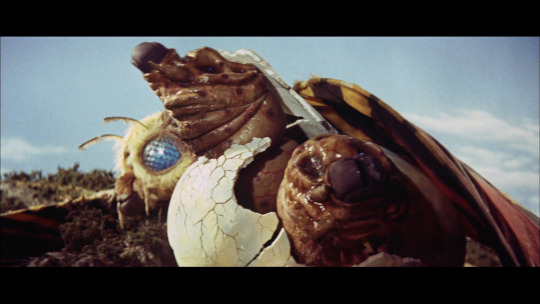
Some have complained that the final act loses steam, as the film has already finished on a thematic level, with the antagonists killed by Godzilla and the vows of a better future already ensured. To which I respond if some people have ever heard of the concept of a final action scene, but I digress; what caught my eye with this viewing is that Godzilla’s final targets are a group of schoolchildren on an island that can’t escape because all the boats have already left. The protagonists are able to have time to rescue them as the Mothra larvae contend with Godzilla, and it stands in contrast to the first Godzilla film where we know that children are amongst the body count, children suffer from radiation exposure by being in Godzilla’s presence alone, and had to see their parents die in front of them. Children in this film being rescued without harm feels like the closest this film gets to putting “a better world” into action, moreso than just a means to artificially increase the runtime.
The ending is what gets me. It essentially combines the endings of the first Godzilla and Mothra films. Godzilla was killed in the first film but forced back into the sea in this one, but regardless, while the immediate danger has been averted, nuclear testing still occurs, the conditions that allowed Godzilla to come into existence haven’t changed. With Mothra, she is able to return to Infant Island with what is hers and the Infant Islanders’ been rightfully returned. They’re sobering and delightful respectfully, but combined we know that forces that created Godzilla have also terribly weakened Mothra and her people, and a better world being made by the protagonists includes rectifying this specific situation. You know the scene in Ratatouille (2008) where Remy shows his brother that while strawberries and bananas taste good on their own, the flavor is far greater when eaten together? Yeah.
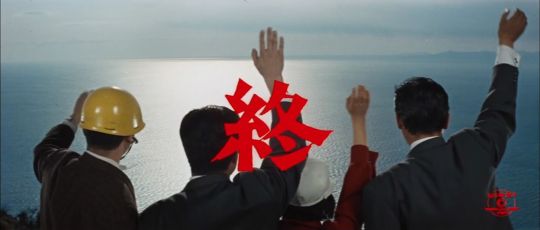
16 notes
·
View notes
Text
Zack Snyder's Justice League Review!
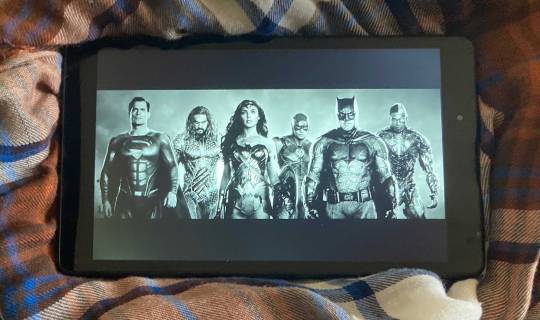
Zack Snyder's Justice League dir. Zack Snyder (2021) Warner Bros. Pictures, DC Films, Atlas Entertainment and The Stone Quarry Science Fiction, Action, Superhero Movie
Rating: 3.5 Waves

Summary: Tormented by visions of a dark future, Bruce Wayne aka The Batman attempts to gather a team of superheroes to defend the planet. When alien tyrant Steppenwolf arrives on Earth seeking a long forgotten technology, this group of heroes must do everything in their power to keep him from locating all three Mother Boxes and destroying the world.
Content warnings: Violence, Death, Body Horror, Gore
This review DOES NOT contain spoilers for Zack Snyder's Justice League
A bit of background for those of you thinking “Didn’t Justice League come out years ago?” You are exactly right! Justice League was released in theaters in 2017 and is the fifth movie in the DCEU (DC Extended Universe). The same company that produced Justice League then funded Zack Snyder's Justice League (2021) which is a different version of the story that was released in 2017. Zack Snyder was actually the original director of Justice League (2017), but he stepped away from the project during post production and the film was handed over to director Joss Whedon. Whedon’s creative decisions led to rewrites, heavy editing and a notorious reshoot that required removal of Henry Cavill’s mustache via CGI. Therefore, Justice League as it premiered in theaters in 2017 was Joss Whedon’s vision of the story. As some of you might remember, Justice League (2017) was considered a “flop” as it lost the studio ~$60 million overall and was received by fans with mixed to negative reviews (6.2/10 IMDB, 40% Rotten Tomatoes). But since Zack Snyder had left so late in the project, there were rumors that his version of the film had been nearly finished and there was hope that the movie Snyder filmed was actually better than what Whedon had created. Fans took to social media to demand that Warner Bros release the “Snyder Cut'' of Justice League and in a move I personally find baffling, Warner Bros actually gave Zack Snyder another $70 million to finish his version. Zack Snyder's Justice League (2021) which was released on HBO Max is the final product.
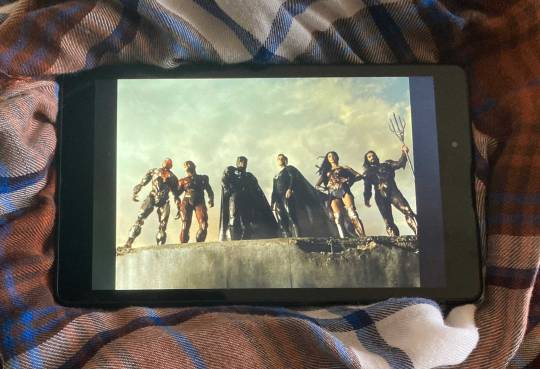
While understanding the context of how this movie came about is neat and honestly pretty hilarious, I never got around to see Justice League (2017) so I cannot give any commentary on whether this new film is any better. For those who are curious, my fiancée who has seen both says that the movies are extremely similar in plot, but there are significant changes to characterization and pacing. This review will solely be on the merits and shortfalls of Zack Snyder's Justice League (2021) in a spoiler free context since the movie was released just over a week ago (if you want to talk spoilers DM me I have So Many Thoughts).
Honestly, I was surprised how much I enjoyed this movie. My expectations were quite low considering what I heard about the original 2017 version and the fact that I’m more of a Marvel fan. The most surprising thing for me was that I sat through the entire 4 hr and 2 min runtime (for reference the runtime for Justice League (2017) is 2 hrs). Aside from Lord of the Rings (Return of the King runtime 4 hr 11min), I usually don’t indulge in movies that require me to block off an entire day, but I was curious and I love bandwagons.
The highlight of this movie are the characters. Each of our main characters had a deep, solid backstory that drew me in and made me invested in what was happening in this world. One thing lacking in a lot of ensemble superhero movies is balanced screen time between the main cast, but Zack Snyder's Justice League (2021) uses its time wisely to give each character depth and critical purpose in the narrative. Even the villain had compelling motivation as to why he is on earth doing dastardly deeds, and while I wasn’t rooting for him, I respected his motivations. I also appreciated that the writers of this movie made the characters intelligent. Sure, some decisions were driven more by emotion than logic, but the way defenses are set up and how our heroes use their unique powers left me incredibly impressed.

The characters’ interactions with each other was also very enjoyable. Snyder took the time to include scenes centered around the team chilling with each other in ways that were refreshingly low stakes and mundane. The story was interspersed with scenes like Wonder Woman and Alfred making tea, Aquaman and Wonder Woman musing over cultural differences, and Cyborg and Flash digging up a body where you could really see the characters grow from strangers to teammates to friends. These scenes also peppered in some light humor that kept the movie from becoming too dark without distracting from the tone.

Since Zack Snyder's Justice League (2021) is technically an action movie and it is rated R, I feel like I should touch on the action sequences. Overall, the action was incredibly fun to watch! It was made for the big screen so watching the epic battles for the first time on my TV at home was a bit underwhelming, but the well choreographed, high stakes fights were still visually pleasing. For a rated R movie there was not as much gore as there could have been, which I appreciated and the level of violence was pretty much what I expected from a comic book movie.
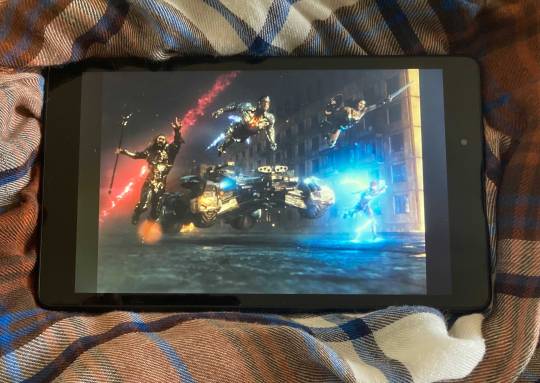
The action scenes also do a fantastic job with power escalation. By that I mean the action illustrates the limits of one character’s power clearly in relation to other characters’ powers. This way you are aware of exactly how impressive the characters and their powers are on their own and so when someone or something stronger shows up we have context for how big of a threat we are dealing with. The clean way the story shows us everyone’s respective powers and their limits makes it so the stakes feel more tangible and it's not just unfathomably strong characters beating the shit out of each other with the winner decided by chance.
There are a few reasons the movie didn’t get a full five waves from me. First was that the Amazon’s outfits were very clearly made by horny men based on how much skin they were showing. I, a bisexual, personally love to see superheroes in less then full coverage, but when the Amazon warriors have their entire stomachs and cleavage out of their armor for no reason it exhausts me. What happened to the tasteful and stylish armor from Wonder Woman (2017)? This feels like a step in the wrong direction.
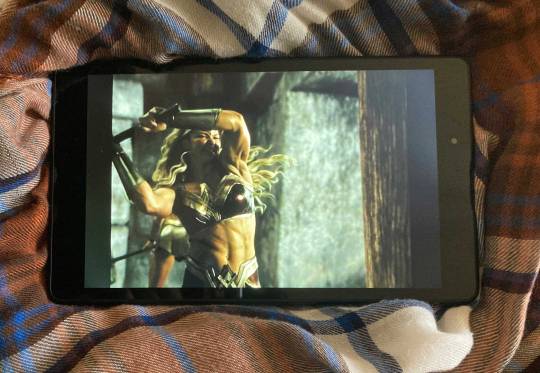
The next concern I have that has kept me from recommending this movie to people is the overall pacing and length. While there were some great uses of the extended run time like the action sequences and team bonding I mention above, there were so many scenes that were way too slow for me to stay engaged. I found myself editing the movie in my head, like did we really need 2 full minutes of Bruce Wayne and his horse climbing a dreary mountain? I don’t think so. This was a narrative where I needed to pay attention lest I miss critical pieces of the story, but the random scenes that dragged on too long had me going to get snacks and checking my phone throughout. If I could rate the movie by halves the first half would get 2.5 Waves because of how it dragged and the second half would get closer to 4.5 Waves since the story really picks up and fun things start to happen.

The final part of this movie that kept it from getting a higher rating was how closely it was tied to Batman v Superman: Dawn of Justice. In fact, the first scene of Zack Snyder's Justice League is the final scene of Batman v Superman. There were many plot critical tie-ins to previous movies that left me feeling confused until I googled my questions during the slow scenes. If you have never seen Batman v Superman or Man of Steel then you will miss a lot of this movie, which I thought was unfair because other DCEU movies came out before the first iteration of Justice League like Wonder Woman and Suicide Squad and while events in those movies are mentioned in passing they are not nearly as important as the Batman and Superman-centric films. If the DCEU is going to pick favorites, the least it can do is pick movies I actually like (Wonder Woman (2017) remains my favorite DCEU movie to date). In general, superhero movies seem to be trending toward sagas and I prefer movies that you can just watch and enjoy without needing to see a bunch of other movies first.
Overall, I did very much enjoy this movie, but based on the run time alone it is not going to be for everyone. Measuring movie success during the pandemic is trickier than looking at box office numbers and labeling it a success or a flop, but it does appear that Zack Snyder's Justice League (2021) is doing well as far as critical reception and viewership. I hope that this success will allow the DCEU to explore all of the fun nooks and crannies of the universe Snyder pulled together. In fact, half of the epilogue of this movie felt like set up for future movies. I hope they come to fruition because there were some pretty compelling teasers at the end that I would love to see played out on the big screen.
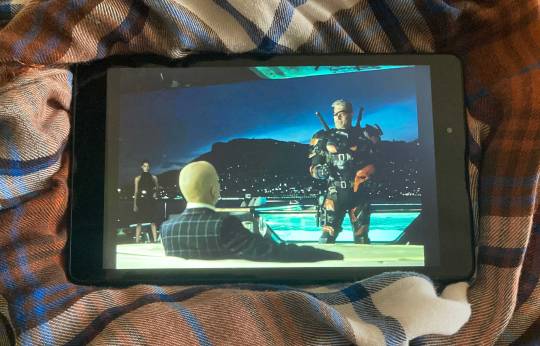
As I mentioned before, I’ve never seen the original cut of Justice League, but Snyder’s version left me fulfilled and satisfied with the narrative, so I am happy to have seen this newest cut first. This is a movie for people who love DC, love superhero movies or are just really invested in the hype.
~TideMod
#Zack Snyder#the snyder cut#zack snyder’s justice league#Justice League 2021#Justice League 2017#DCEU#DC movies#Justice League#spoiler free#TideMod#wehavethoughts!#WHT!#reviewblr#movie review#film review#long post#action movie#superheroes#superhero movie#wonder woman#aquaman#the flash#cyborg#superman#batman#steppenwolf#mother boxes
5 notes
·
View notes
Text
@falconowls replied to your text post
I do also have a thought that many Disney's films really need more writing improvements as time passes. One of the main issues is that it is getting more unrealistic, exaggerating and sloppy. Movies are becoming less inspirational and disappointing. Even when you do remakes or based on something, they shouldn't just using CGI or live actions to do so, but actually adding a theme that motivates and inspires.
Likewise, not just remaking The Lion King with new voices and CGIs, and just focusing on remaking everything just for making money. It seems that Disney was more creative and inspirational before. Even when you're talking about 60-70s animations or older franchises films like POTC, 20000 leagues under the sea, the sorcerer's apprentice etc. You can feel a deeper depth of art, emotions and reflections.
Perhaps Disney's older works are much more daring but still realistic. Indeed, with things full of imaginations, yet still brings out messages of struggles, humanity, dreams, and much more. Not just visual effects and cool actions.
And what I think is that what a perfect story or a plot should add their 'imperfections'. In Avengers (I still like the series), everything seems too perfect, like having conversations or jokes in a battle field, saving everybody, always about saving the world, always about high tech stuff and super actions. It makes things seem childish, and bland, and over exaggerating. I know it's pg and superhero, but you can still do more.
In my POV, even when there are plot holes, timeline mistakes, or disapproving scripts in X men, I can feel the emotional depths and struggles, as well as a strong, unyielding theme in every chapter- That how different people are treated and their struggles in society, and how we should treat difference in the right way.
And there are more emotional depths and realistic scenes. Eg. Charles and Erik's reflective views on mutant and human future. Erik could not save his mother and family, and following the path of the man he hates most. Logan's tragic life, Jean's unstable mind, guilt. Charles endless hope and love... Many characters that reflect on humanity, our choices, views, life struggles...
One more outstanding theme is that how powers affect us, like apoc and shaw believing themselves superior and meant to rule all others, while Charles and x men sees their powers as protections to the weaker ones. Just like Hitler vs Lincoln. These powerful beings in fact own a heart of humans. Sometimes what flies high still need times to stay on the ground. Disney in fact can do so, like what they did to good works.
These are but my opnions, which I would like to share. No offense to anything.
I’m afraid I dropped out of the X-Men series because I was too bored, on the other hand I literally forced myself to bear through most of the MCU and in fact there’s multiple movies I have never watched, so.
I think that the point is- like @shinychimera was saying, movies are generally made in a hybrid art/business model and that’s what Disney used to be for most of its history, there’ll be a tension between business requirements and artists’ visions but generally that gave birth to good products - with the occasional Bad Idea, meh thing, piece of weak writing, etc, but mistakes are inevitable and in hindsight everyone can tell what went wrong. Some projects would be given less funding some more, etc etc. Sometimes you expect something to be a bad idea but the audience loves it; sometimes the opposite. But overall you try to go with something that the audience will most likely like because you need the product to be successful.
The problem is that until not so long ago the idea was that for a movie to be successful it had to be good. Which kind of sounds obvious but becomes less obvious when you are a massive megacorporation that has a near monopoly on what gets aired in theaters and massive global brand power.
That’s the difference between the works we grew up with (for me at least it was Howard Ashman’s movies and the rest of the Disney renaissance) and the movies that are being produced now. I think it’s a big difference.
The Avengers are a collection of witty one-liners wrapped in CGI, yes. It’s one of the most glaring examples of fandoms that are built on potential, and as the series progressed it became increasingly obvious that that potential wasn’t going to be explored, but what was there was all there was.
7 notes
·
View notes
Text
Real life Na’vi tribe, the Blue Moon Tribe, and realistic goals of going off-grid
In late 2009, James Cameron’s “Avatar” film came, and with it, the Avatar-related forums. There were Avatar forums, Tree of Souls, and Learn Na’vi.
While the film made an impression on me in terms of its world-building and aesthetic beauty, it did not challenge my view on lifestyle or give me ideas on how to live in the future.
But for some, it did. It was in August of 2010 that I (then nineteen years old) was reading around on the aforementioned Avatar boards, where there was a very(!) lengthy (I believe 50+ pages by the time I found it?) thread regarding the idea of making your own “Na’vi-style” tribe, as a lifestyle.
I read the first few pages and thought “Ha! Fun idea, but I could NEVER-” I kept reading. It took me two whole days to read the entire thing. I went from “maybe I could do it during the summers during the seasonal idea they are discussing, but I couldn’t live forever without my books-” to “I WANT TO DO THIS”.
At nineteen, I was at a standstill in life and had no idea where to go from there. All I knew before this was that I wanted to live in the countryside, but I had no idea and no help on how to make this a reality.
This was something completely new to me, that seemed extremely appealing. I had actually watched Into the Wild just a few months prior, but had no inspiration from it (maybe because it was Alaska, then completely unappealing to me, and the poor guy did starve to death).
By the time I found them, the thread had been broken off into its completely separate, non-Avatar-related forum. They were very clear that while Avatar forums is where they met and were inspired, the project was a serious thing and had nothing to do with “larping” or trying to live literally like Na’vi. The forum was called “the Revolutionists”, better name pending.
The oldest member, who also had the server to the new forum and was one of the most active members, was 37 at the time. The youngest was only 15, and I’d say the average age was around 21. We numbered around 15-20 committed members.
The knowledge was great among some of the members, talking about permaculture, water and waste systems, et cetera. A chat room was set up, and while we had some structured meet-ups in there, there was almost always someone there.
I was extremely inspired, but knew nothing, so I mostly stayed silent, read and listened. Over the next year, I consumed everything I could find regarding “tribal living” or “going back to the wild”. Even then, in 2011, the internet was a much smaller place than today, and it was very hard to find decent resources.
Eventually, in a live chat, the name “Blue Moon Tribe” was decided on for the group. “BMT” had a lot of ideas, some of which I’ll list to give an easy overview...
Permaculture, not pure hunter-gatherer, as it is not feasible today
Hunting for meat, as raising meat animals was never considered
Animals like dogs and horses would be allowed
Funding/permission for the project by allowing researchers to study us as a “social experiment”, as surely this has not been attempted before?
Firearms vs just archery were lightly debated, but as far as I remember, never settled on
Hanggliders and other means of flying were discussed quite a bit, inspired by the Na’vi “Ikran”, but put into reality by perhaps being used to survey forest for the government (essentially as another means of being permitted “stewardship” of a piece of land rather than buying it)
Permanent life, including children and birth control were discussed at some length
We would live in a firm spot, with some sort of permanent structures
An enormous piece of land would be required, due to having to live largely off of hunting - we actually never calculated this very well (how much meat/person/year, how many animals per acre, etc.), but estimated it at 1000+ acres for a reasonable size tribe of ~20 people. This was one of the two ultimate death blows of the project.
Where in the world would it be? Members lived everywhere from the US and UK to Sweden, Germany, Chile, the Philippines, and more countries. Visa requirements for anyone moving would be daunting. I really tried researching this, but it never went anywhere, and it was the second death blow to the project. Never a set location. (In hindsight, it would be best to just aim on the US and be done with it. Or two locations, one American and one European.)
I went from being a very quiet student in the beginning, to becoming one of the leaders in “keeping it going”, when things seemed difficult, by keeping writing new threads, and trying to solve our most pressing problems - money (for buying land) and where to move.
I researched almost every country imaginable, made in-depth charts of my research, and felt most like some of the more well-off Latin American countries would fit us best, like Panama, Argentina or Mexico. A problem with tropical countries is that they often ban hunting. Spain could also be a good fit.
Note that while I researched most of the world (including southern Africa and all of southeast Asia), I excluded most of Europe, as after growing up in northern Sweden with winters easily going below -20C, I thought I loved the heat. :D (Oh I learned after visiting Tbilisi in July...)
My focus wasn’t all selfish, of course, and growing seasons were much better in warmer climates. Mostly, we(!) focused on the subtropics.
But the years passed, and nothing happened. Not even the real life meeting we had discussed.
There was another group, meanwhile, that had been inspired from the same Avatar source, but had remained on its forum, Learn Na’vi - we called this the “real life Na’vi tribe”, with no official name. I was active on this forum as well, mostly to help, as I saw myself joining this project in real life unlikely, but if they succeeded first, maybe I would.
Overall, this other project was far less organized, with more “casuals” coming for a week and then leaving (both projects had this problem early on, in 2010), less structure and dare I say, less maturity. Some mature voices pitched in, but they mostly had no personal interest at all, they simply wanted help people keep their feet on the ground.
In the beginning, some really outlandish ideas were suggested, and it had a far greater focus on NA’VI RE-ENACTMENT, even though this faded in favor of... reality. Obviously no one is going to spend their entire life living like fictional aliens from a movie.
Reducing the project to a simple summer camp was discussed, as well as the idea of separating it - not in locations, but having two parallel projects in the same location. One would be the “true” tribal life, and then an ecovillage nearby for a “softer” approach. I urged them to go for the ecovillage, period, but it was ditched altogether instead.
This group seemed less happy with having animals, even horses (though I joked to myself, “Hey, even the Na’vi have horses?”), but the focus was still on a huge plot of land for hunting.
After a few years of doing even more poorly than BMT, the entire forum category on the Learn Na’vi forum was locked, due to inactivity. The project had officially failed.
For BMT meanwhile, members kept falling away. Someone realized he didn’t want to leave his country and have to speak English for the rest of his life. Someone else found a career they wanted to focus on. Someone else joined the army. Life happened, we were mostly 18-24 year olds, and did not have as much foundation in our idea as we thought.
When I “left” in early 2015, there were maybe 3-4 of us left in a different chatroom, as our entire forum had been taken down by hackers, and it was never reinstated. (Oh how I grieve this, as while the project is dead, there were droves of great information on it. The original thread on Avatar forums that birthed the project is also gone, as the entire forum is down.)
I was clear that I didn’t leave the plans to have an off-grid lifestyle, only Blue Moon Tribe, as it was obviously dead, despite my best efforts to keep it going. (Not to give myself too much credit, I was never a “leader” of the project or by any means the most knowledgeable, but I did take upon myself the role of inspiration and keeping people’s spirits focused.)
I met some of the other members on Tree of Souls later, where there was a thread with people asking what happened with these projects. It all basically ran off in the sand, as we say in my language.
It’s been almost six years since I left, why talk about it now? Because I keep thinking about it. What happened, why it died, and what we could have done instead.
First off, I would not join this project today.
This project taught me that off-grid life was a thing, and not just a dream, but a feasible lifestyle. I had never heard of it before finding the then still unnamed Blue Moon Tribe.
I am still very actively working on my off-grid future, but it is a very different lifestyle from the one these groups planned.
During 2015, when I went complete lone wolf and planned it only for myself, I downsized and downsized until I (reluctantly) realized a few acres is all you need. Most hunters (and I still do plan on hunting) don’t own their own acreage. You can hunt for food without owning the hunting land.
While I was completely fine with hunting, I felt extremely squeamish with killing animals I raised myself. After watching enough YouTube videos, I got rid of this fear and decided to have chickens and rabbits as well. I was focusing on Spain, or perhaps Ireland or Croatia, as my off-grid destination.
Later that same year, I met my husband, a man who had dreamed of living in Alaska or the Russian far east since early childhood, and we made our plans for the future together. Our first few weeks meeting in real life were spent staying up late at night, talking for hours and hours, mainly about off-grid life.
During the years before it failed, in 2013 specifically, I found the then phenomenal (it has really gone downhill in recent seasons) TV series “Ben Fogle’s New Lives in the Wild”. So many different people who have found their “wild life”, in so many different locations and ways, from so many different backgrounds and outlooks. It is a gold mine, and I would have drooled over it even more if it existed back in 2011. It would have helped our project tremendously.
During 2011-2012, I also looked up ecovillages. Mostly just for research, to see what they were doing, but also, possibly, to join. (The existence of hundreds upon hundreds of ecovillages made our project members realize BMT’s idea was not that unique and that the “let researchers study us”-idea may not be so feasible...)
I found that, out of ~200 ecovillages I looked up around the Americas and southern Europe, at least half were vegetarian or vegan in their rules, and while the other half permitted meat-eating, not one hunted or raised meat. I found one project in Hawaii (only a single family, no one else yet) that had chickens for eggs and cows for milk, but that’s it. Lots of woo-ey spiritual retreats and that kind of thing, not a lot of long-term living.
Something I learned from New Lives in the Wild, is that while many do this alone or with their family, only a handful of these projects were “communes”, and they were mainly made up of hippie-like, transient young people coming and going. Same with my ecovillage research, I did not find a single true village with families creating a permanent existence.
So, on to my criticism of projects like these, and why they are doomed to fail without much better foundations and goals:
Unstructured/unrealistic goals, as it was the death blow of both projects. We had no real calculations on how much land we would need, for what, and how much money would be needed.
No set location from the get-go. Again, we should have just said “US”, picked a state (as there are tons of resources on this), and let that be that. At least half of the members were American.
Creating a community meant to last is hard. One kind piece of advice I saw on the Real-life Na’vi tribe was that “you won’t be able to make it work without a common spirituality”, and I, as the then diehard atheist, dismissed it straight away, but she was right. Without common cultural/racial/spiritual roots, or a spiritual common goal (”converts”, not as easy as people who have been raised in it, but better than nothing), communities like this will break up. It is just human nature. Without strong foundations in culture and spirituality, there is no “social glue” to keep you together through the decades.
As a side to the same point, most people simply can’t live in these artificial communities long-term. I know now I couldn’t, and I realized that in 2015. I am much too introverted and non-conformist to live in a “group”. We could be neighbors, but anything more than that would feel too “suffocating” for me, and conflicts would be inevitable. I’m also sure some of these members would today be on polar opposites of the political conflict, and so would be unlikely to even get along.
I believe the Blue Moon Tribe could have survived with better resources and better planning, but the major pitfall for its long-term survival (people living together for decades to come) would be its lack of “social glue”.
One of the unofficial “leaders” and the oldest member of the project, left because, as she said, she felt more attached to her homeland the older she got, and could not imagine leaving. She was ten years older then than I am today, and I feel the same way, now in my late twenties.
In my early twenties, I longed for “exotic” and “far away”. I wanted tropics or subtropics in a far away land. Cob houses.
In my late twenties, I long for rustic log cabins in the boreal habitat, as close to home as possible. I have seriously considered Chile, but aside from immigration problems, being so far away on the southern hemisphere with no boreal fauna bothered me as well. I think this is a natural progression through early adulthood.
Years ago, I thought rural Scandinavia was so boring.
Now, I watch videos of those who live this lifestyle in their ancestral village in Sweden, and weep with envy. I can never do that, not just because of the harsh winters, but because I can’t stay in Sweden for legal reasons. (A very important law that has no chance of change in the coming decades, and which makes it impossible for me to stay.)
I now live in Norway, and will probably stay here. My husband and I are currently gathering money - about halfway to our goal so far (we have only been able to actively save money for a year, so this will only take another year or two) - to buy a plot of land, perhaps inland, near the Swedish border - and live our lives there, in the woods, the way we want.
All our dreams won’t be realized, as some dreams are simply meant to stay that way, and the world is no longer free - but it will be as close to paradise as we can make it.
#off grid#homesteading#permaculture#going tribal#new lives in the wild#avatar#na'vi#living in the wild
10 notes
·
View notes
Text
Whenever I discuss Sleeping Beauty with someone who doesn’t share my enthusiasm for Disney, they have an irksome tendency to get it muddled with Snow White; their excuse being “it has the same plot”. I’ll admit, there are some surface similarities that even the most casual viewer can pick up on: a fairytale where a princess is forced into unconsciousness and wakes up with some necking, the comic relief and villain being the most beloved characters, a little frolic in the forest with animals, the antagonist plunging off a cliff, you get the idea. In fact, Sleeping Beauty even reuses some discarded story beats from Snow White, mainly our couple dancing on a cloud and the villain capturing the prince to prevent him from waking his princess. Yet despite that, Snow White and Sleeping Beauty are two wholly different movies shaped by the era and talents of the time.
I’ve discussed how Walt Disney was never one to stick to a repeated formula, no matter how successful it was. He must have noticed the parallels between his first movie and this one, but decided to make one crucial change for Sleeping Beauty that would forever differentiate the two: the look. We all know the traditional Disney house style: round, soft shapes, big eyes; charming as it was and still is, Walt was sick of it after several decades. Meanwhile, artists like Mary Blair and Eyvind Earle were producing gorgeous concept art that rarely made a perfect translation into the Disney house style.

Walt wanted to make a feature that took the pop artistry of their designs and made the animation work for it instead of the other way around – which brings us to another animation studio that was doing well at the time, United Pictures Animation, or UPA.
UPA didn’t have the kind of budget Disney normally had for their animated projects, but what they lacked in fluidity they made up for in style. Watch The Tell-Tale Heart, Gerald McBoing-Boing and Rooty-Toot-Toot to see what I mean. UPA were pioneers of limited animation, taking their scant resources and creating some striking visuals with bold geometric designs. Through this, they defined the look of 50’s animation. Though perhaps unintentional, Sleeping Beauty comes across as Disney’s response to UPA, or what would happen if UPA had the funds they deserved. The characters’ contours are angular but effortlessly graceful, defining their inherent dignity and royalty. And the colors, ohhh the colors…
Because of the immense amount of work required to animate in this difficult new style (and in the Cinemascope ratio, no less) as well as story troubles and Walt barely supervising the animation studio now that he had his hands full with live-action films, television, and a theme park, Sleeping Beauty had a turbulent production that lasted the entirety of the 1950s. For a time, Chuck Jones of Looney Tunes fame was set to direct. Director Wilfred Jackson suffered a heart attack partway through production and Eric Larson, one of the Nine Old Men, took the mantle from there before Walt Disney replaced him Clyde Geronimi. And even after that, Wolfgang Reitherman teamed up with Geronimi as co-director to get the film finished after no less than three delays. Also, Don Bluth got his foot in the door as an assistant animator for this feature, beginning his short-lived but impactful tenure at Disney. Did all this hamper the movie, or did they succeed in what they set out to accomplish?
Well, one of the reasons why this review took so long was because I had a hard time not repeating “MOVIE PRETTY” and “MALEFICENT AWESOME” over and over. Make what you will of that.
The story begins as most fairy tales do with your typical king, Stefan, and his queen suddenly blessed with a baby girl after years of wishing for a child. They christen their daughter Aurora (middle name Borealis, localized entirely within their castle) and throw a huge celebration in her honor. People come from all over the kingdom to pay homage to the princess and OSMKFKSBFHFGILWBHBFC…
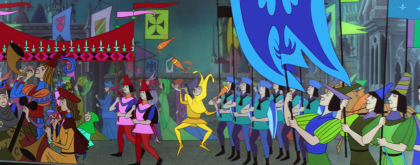
Movie pretty…
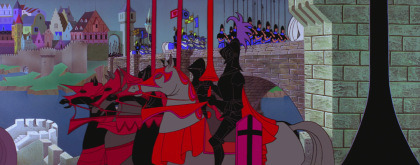
Movie pretty…
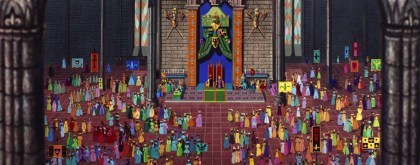
MOVIE PRETTIEEEEEE…
John Hench, Academy Award-winning special effects man and art director, turned Walt on to the idea of basing the look of Sleeping Beauty on classic medieval artwork. Thanks to him and Eyvind Earle’s insanely detailed designs and backgrounds, this is one of Disney’s most visually distinct and beautiful films. A single still from this feature wouldn’t feel out of place up in The Cloisters.
Among the party guests is King Stefan’s old friend King Hubert (Bill Thompson) bringing his young son Prince Philip. Stefan and Hubert wish to unite their two kingdoms and formally announce Philip’s betrothal to the infant Aurora.
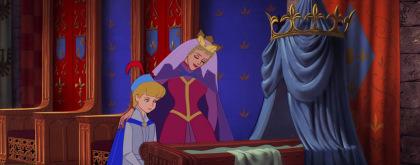
“We were going to do it during the second trimester, but we decided to wait until she was more mature.”
By the way, your eyes are not deceiving you. That is Aurora’s mother, Queen Leah, alive and well and named. And frabjous day calloo callay, she even gets some lines! The most common joke about Disney princesses is that they don’t have moms (even Ralph Breaks The Internet went out of its way to highlight that), so as a hardcore Disney fan who often has to put up with this generalization, Leah’s existence leaves me feeling vindicated.
Once that happy revelation is out of the way, we’re introduced to our main protagonists.
Oh, you thought I was referring to Philip and Aurora? Nonononono, my friends. THESE are the true heroes of Sleeping Beauty, the Three Good Fairies.
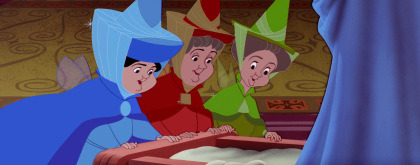
The fairies started off as one-note side characters sharing the same personality. Think pre-Ducktales-reboot Huey, Dewey, and Louie in dresses. But the studio had a difficult time giving Aurora more depth and was having a lot more fun developing the fairies. Naturally, they became so fascinating and appealing that more screentime was given over to them. Now the story’s carried by three wonderfully fleshed out ladies who are distinct in both looks and personality: Flora’s the pragmatic tradition-adhering leader, Fauna’s the sweet scatterbrain who mediates, and Merryweather’s the feisty young upstart.
With the plot now focused on characters who held a traditionally minor role, it’s easy to read this as a perspective-flipped version of the fairytale, but there’s more to it than that. Remember in my Clash of the Titans review how I mentioned the gods literally play chess using the heroes as pieces? I tend to view the main conflict of Sleeping Beauty in the same way. The Three Fairies and Maleficent are in a constant game of good vs. evil, moving Aurora, Philip, and the rest of the royals as pawns in their plans. There’s plenty of plotting and intrigue, with both sides constantly guessing and second-guessing the other’s next maneuver, and even if you’re already familiar with the story’s trajectory you’re still left on the edge of your seat as it inches towards the fiery climax.
And dare I say it but…the fairies and their power dynamic make this Disney’s most feminist film. Yes, really. You could argue that some of the other animated movies from the Renaissance and Revival period have more notable, stronger female protagonists, and many of the live-action remakes try to be woke without really grasping the concept, but consider this: The cast of Sleeping Beauty is mostly female, the leads aren’t objectified in any manner (that is if you count Aurora as a supporting character), nor does their gender factor into their competency, each one differs in age and body type, and most of them are working together towards a common goal as opposed to against each other. Name a movie in the past decade that does the same and still manages to be entertaining (no, really, I’d love to see it). There’s even one scene that unintentionally provides great commentary on the divides in the feminist movement, but more on that later.
Flora and Fauna bless the baby with beauty and song respectively which are accompanied by a short chorus and some sumptuous graphics. I don’t think I need to reiterate that when this movie goes extra with the visuals, it GOES EXTRA with the visuals. Next comes Merryweather with her gift. To this day, no one knows what Merryweather intended to give Aurora. Flora’s the most traditionally feminine of the three so her giving Aurora beauty comes as no surprise. By comparison, Merryweather is the most forward (or unconventional, depending on your point of view). I wouldn’t put it past her to favor Aurora with intelligence, or humor, or passion, or creativity or humility or confidence or decisiveness or physical fitness or great swordsmanship or telekinesis or ice powers or one million YouTube subscribers or comfort in her female sexuality.
Me personally, I think I’ve got the best gift of all:
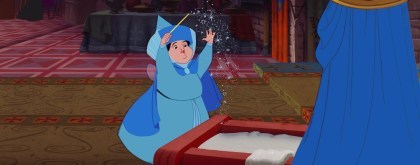
“O Princess, my gift shall be…getting all reviews posted on time for once!”
Alas, before Merryweather can bestow such a wondrous quality upon the child, she’s interrupted by a horny party crasher.
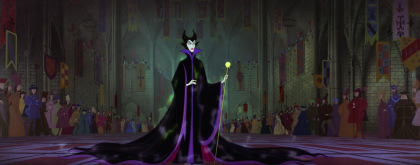
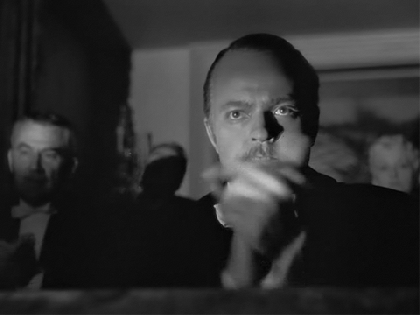
Maleficent. The Mistress of All Evil. Chernabog’s right-hand witch. The Disney villain all Disney villains strive to be. She has it all – the looks, the poise, the power, the laugh, the cunning, the ruthlessness! She doesn’t even need to sing a song because she’s already awesome enough without one. Marc Davis’ gothic design cuts a fine figure and Eleanor Audley’s subtle icy voicework is trés magnifique. As much as I enjoy Audley as Cinderella’s evil stepmother, Lady Tremaine was but an appetizer in comparison to the four-course banquet of pure villainy that is Maleficent.
This leads to a small point of contention some viewers have with Maleficent in spite of hitting top marks elsewhere: her motivation. Putting a hit out on a child for not getting invited to a measly party? Not exactly compelling, is it? And yes, it isn’t a deep motive…is what I would say if I wasn’t well-versed in folkloric tradition. In the original fairy tale and the movie (though it isn’t outright stated in the latter), the party for Aurora isn’t just your average royal kegger, it’s a christening. Back in ye olden days, christenings were very big deals. To not receive an invitation to one was a grave insult, so not extending an invite to your semi-omnipotent magical neighbor is just asking for trouble. In the fairy tale’s defense, no one had seen the evil fairy for years and assumed she was dead, though I can’t imagine how nobody thought Maleficent wouldn’t find about it eventually.
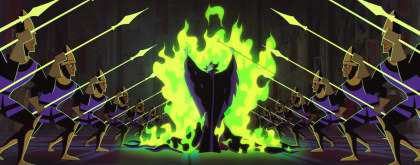
“You dare to deny me, foolish mortals? Very well, then! I shall have my own christening! With blackjack! And strumpets!”
Maleficent is proof that sometimes you don’t have to have an elaborate backstory, a god complex, a tragic past or the unfortunate luck to be on the wrong side of a conflict. Sometimes all you need is some magic, brains, class, and a whole lot of flair to be a perfect, intimidating, and unquestionably iconic villain.
Basically what I’m saying is these movies never happened. Got it?
Maleficent is disarmingly polite over being snubbed, even after Merryweather bluntly tells her nobody wanted her to come. She even brought her own gift for the baby – sixteen years of life cut short by the prick of a spinning wheel spindle, because why change into a dragon and destroy everyone all at once when you can draw the torture out over an agonizingly long time and deliver the coup de grace in the prime of a young woman’s life? That’s how Maleficent rolls, baby. She could dole out capital punishment when she has to without batting an eyelid, but causing human suffering is her bread and butter.
Stefan begs the fairies to undo Maleficent’s curse, but it’s too strong for them. Flora and Fauna insist, however, that Merryweather can use her gift to lessen the spell’s potency. Now instead of dying from that fatal prick, Aurora will sleep until she receives True Love’s Kiss™. Stefan’s not one to throw caution to the wind though, so he orders all of the kingdom’s spinning wheels to be burned in the meantime.
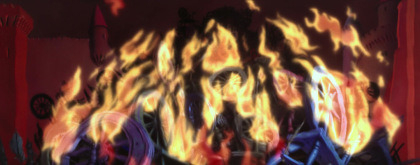
I just pray his kingdom’s economy wasn’t based on textiles otherwise they’re screwed.
As the peasantry celebrates Guy Fawkes Day several centuries early, the fairies ponder their next move. They’ve been around long enough to know that removing spinning wheels from the equation won’t put a damper on Maleficent’s scheme. This scene is incredibly effective in establishing two things:
Maleficent’s near-omniscient presence in the film
How well the fairies’ differing personalities play off each other
Maleficent rarely miscalculates her opponents, and that guile puts her one step ahead of the heroes, making her one of the few Disney villains to nearly reach their goal. The only mistake she makes in the entire movie is trusting her henchmen to do their jobs when she isn’t directly supervising them, though that’s more on them than her. The different methods the fairies propose to deal with Maleficent fantastically illustrate what kind of people they are. Fauna believes she’s just a miserable soul who could be reasoned with if they talk things over. Merryweather would rather take the fight to Maleficent and turn her into a toad. Flora, however, is wise enough to know Maleficent’s too wicked to plead to, too clever to bargain with and too strong to face head-on, so their best course of action is to focus on protecting Aurora through any means necessary. Her initial idea is to enchant the princess into a flower (her namesake is her specialty, after all), but Merryweather reminds her that Maleficent enjoys creating bitter frosts just to kill her flowers.
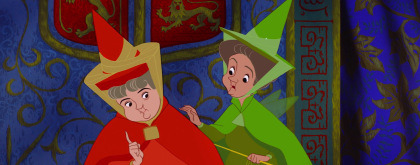
“Well we could try that but stick her in a castle with a beast for a while…nah, that’ll never work.”
Yet never one to give up, Flora alters the plan so they’ll raise Aurora as a peasant girl out in the woods. This means disguising themselves as humans and giving up magic for sixteen years so as to not attract Maleficent, but that amount of time is like twenty minutes to the fair folk. Stefan and Leah reluctantly agree to the plan, and the fairies spirit little Aurora away from the castle that very night.
Sixteen years later, Maleficent is infuriated that her minions have failed to locate Aurora, even more so when one reveals that they’ve spent the whole time looking for a baby instead of a maturing woman. In an interview with the Rotoscopers podcast, Don Bluth called Maleficent a very flat antagonist because she surrounds lackeys dumber than her so she could be the smart one among them and, again, her supposed lack of motivation. But come on, let’s not entirely condemn the bad guys for having too much faith in their underlings. It’s difficult to find minions smart enough to carry out orders but dumb enough to stay unquestioningly loyal. Usually you have to register as Republican in order to get some.
Maleficent gets her anger out in the most therapeutic way – throwing lightning bolts at her orcs, awesome – then leaves the job of finding Aurora up to her trusty raven Diablo. We then finally see the grown-up Aurora herself, whom the fairies renamed Briar Rose as a nod to the Brothers Grimm version of this tale.
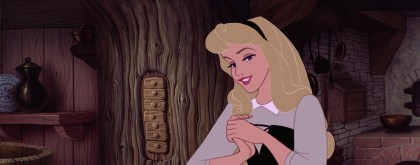
I know I’ve made the occasional case for the princesses from Walt’s era compared to the present day, and yet I have a hard time defending how…I don’t want to say bland. Bland would mean there’s nothing interesting about Aurora, and that’s a lie. She’s gorgeously designed and drawn, and even in her peasant dress she has an air of elegance and sophistication. She carries herself like a queen; her innate royalty reveals itself in her graceful movements. Mary Costa also gifts her with an excellent set of pipes. Hearing her song echoing through the forest is nothing short of magical. She’s a flower child who can talk to animals. She has dreams of escaping her adopted aunts’ loving but stifling care and being allowed to grow up, see the world, actually talk to people, and even find a life partner. She has some strong potential. It’s not that Aurora’s boring, she’s just not quite as developed as we’ve come to expect our animated female protagonists to be. I’m grateful for what we’ve got, but I only wish we could have more. What was her childhood like? How did she learn to communicate with animals? When did the fairies trust her enough to let her spend time out on her own? Did the fairies ever subtly teach her lessons in royalty through lessons and games? Heck, nobody bothers to keep her informed about Maleficent or her curse, and they act surprised when she’s shocked to learn she was a princess the whole time. I want to see what Aurora could have been like if she had known the truth already and what kind of steps she would take to defend herself. Blame the source material for this; it’s difficult to write a compelling main character when she’s supposed to sleep through most of her story.
The fairies send Aurora on a fetch quest so they can plan a surprise birthday party for her. Merryweather wants to bring their magic wands back out for the job, but Flora insists on taking no chances now that they’re in the home stretch. Fauna gets to live her dream of baking an elaborate cake (it’s thanks to her referring to a teaspoon as a “tsp” that I do it too), and Flora insists on making Aurora a gown fit for a princess using Merryweather as a dummy. And we also get one of the best burns in the Disney canon:
Merryweather: It looks awful! Flora: That’s because it’s on you, dear.
youtube
The fairies fall into reminiscing over raising Aurora and get teary over having to let her go soon. I see where they’re coming from, they’re the ones who raised her for sixteen years. They must have so many fond memories, not to mention they put all that work into learning to properly raise a child let alone live like normal human beings seeing how two of them still can’t sew or cook without magic. I wonder what that was like –
No, NO, you CGI abominations DO NOT exist! Go back to the fires from whence you came!!
“Ugh, I’m gonna need something strong to expunge that from my eyes.”
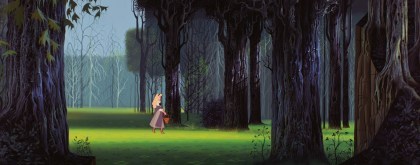
There we go.
Aurora wanders through the forest, drawing out the usual bevy of cute woodland critters with her singing. She also catches the attention of a grown-up Prince Philip (Billy Shirley) who’s more dashing and considerably less blonde than he was sixteen years ago.
By this point, the Disney animators were far more confident in their ability to draw realistic but expressive leading men, hence Philip’s expanded role from the story. He’s also the first Disney prince to have a personality; not a terribly deep or defined one, but it’s a step up from his nameless plot-device predecessors. There are some signs of him being a hopeless romantic, he gets a few funny lines here and there, has a sturdy friendship with his horse Samson, and is fiercely determined when it’s time to kick some ass. He does have the same problem as Aurora in he randomly decides to stop talking for the rest of the movie once he reaches the midway mark (at least Aurora has the excuse that she’s sleeping for that remainder), but I suppose you could chalk this up as to him wanting to spite Maleficent with his silence.
The animals steal some of Philip’s clothes so they can pretend to be Aurora’s dream prince. Aurora plays along as she sings the movie’s standout song, “Once Upon a Dream”. Philip and Samson watch until he smooths his way into the dance. Once Aurora discovers the switch, Philip gets a little too up in her personal space for my liking, constantly grabbing her hand so she doesn’t run off and pulling her closer to him. Not as horrible as what the prince does to the sleeping princess in the original story (a questionably consensual kiss is a trifle compared to how the scumbag of a prince treats her there), but still a bit iffy.
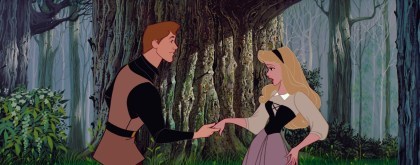
“It’s a good thing my aunts taught me to never go anywhere without a loaded pistol taped to my back.”
But once Philip backs off a little and joins in her song, they both dance together and OEHSGBJSGBLL…

I think I’m going to need surgery to get my jaw off the floor back into its proper place thanks to this movie.
As per Disney tradition, Aurora and Philip’s waltz means the two are head over heels in love with each other. But when it comes time to finally exchange names, Aurora panics and runs away, though she sticks around long enough to tell Philip to meet her family at the cottage that evening.
Back at home, the party preparations aren’t proceeding as planned. Flora’s dress looks as good as my attempts at dressmaking, and Fauna’s dessert wouldn’t feel out of place on Cake Wrecks.
A fed-up Merryweather reads Flora and Fauna the riot act and convinces them to finally take up their wands again. This produces more desirable results, though Merryweather still gets stuck with cleanup duty.
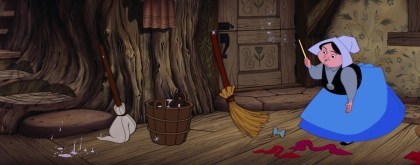
Enchanting a broom to come to life and do your dirty work? I don’t see this going wrong in any possible way.
Things start to go south when Flora and Merryweather argue over the dress color and it escalates into a full-blown wizard’s duel. This gag was supposedly based on the animators’ arguments over what was Aurora’s proper dress color. I think they should have compromised and combined both colors to make purple, which would go lovely with Aurora’s violet eyes, but what do I know. I’m just the illustration major writing a blog. Unfortunately, while the fairies remembered to cover every door, window, and crack that could expose their magic, they overlooked the fireplace. The sparkly residue of Flora and Merryweather’s fight fly up the chimney, alerting Diablo to their hideaway.
Going back to what I said earlier about this movie providing some commentary on feminism, consider this: Flora is obsessed with pink, a traditionally female color, and she gives Aurora an attribute that is oft preferred in a woman but not the most important quality, beauty. Merryweather, on the other hand, is all about blue, a color usually geared towards boys, and she has much more common sense and practicality about her. Though Merryweather and Flora are able to put aside their differences in personalities and approaches for a common goal, it’s when they refuse to compromise and begin prioritizing which color – ie. which ideology and extension of themselves – that they want Aurora to step into that they lose sight of what’s important, and allow everything they worked for to collapse on itself. It’s played for laughs very well, sure, but if not’s symbolic of the dichotomy between traditional femininity and modern sensibility that tears apart the feminist movement then I don’t know what is.
The fairies manage to fix their messes in time for Aurora’s return. She’s thrilled with their gifts but shocks them all when she announces her new boyfriend is coming over for dinner. They come clean about her heritage and betrothal to Prince Philip, and Aurora runs up to her room in tears over the fact that she’ll never see her one true love again. That and her entire life has been a lie and she’s being carted off to meet parents she knows nothing about to marry a man she’s never met and rule an entire kingdom with no prior experience or knowledge. But mostly the true love thing.
Meanwhile, Stefan and Hubert are making wedding plans over wine with “Skumps”, the preferred toast between me and my friends. Also adding to the humor is a minstrel who keeps stealing sips until he literally drinks himself under the table.
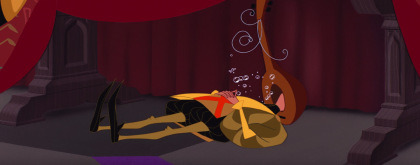
This was also his way of getting through the Black Plague, co-opted by the rest of the world six hundred years later.
Philip returns and Hubert goes to greet him. He thinks his son is thrilled at the prospect of marrying Aurora but is disappointed to learn that he’s fallen for an anonymous peasant.
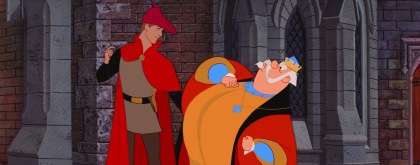
“At least tell me if she’s royalty in disguise so you don’t elope to Sicily!”
Philip rides back into the woods for his big date, leaving Hubert with the unenviable task of breaking the bad news to Stefan. As for Aurora, the fairies smuggle her into the castle and prep her for her homecoming. She’s still blue over having to ghost her forest hubby though, so the fairies give her some time to herself.
Biiiiiiiiig mistake.
So imagine you’re me, growing up watching this movie on tape on a television set with a very standard but not spectacular sound system. Then years later you download the remastered soundtrack and give it a listen while you’re falling asleep. You’ve got the whole score memorized, the volume is nice and low, it’s all good.
And then, just as you’re drifting off, you hear a ghostly voice singing in your ear “Auroraaa…Auroraaaaa…”

That reminds me, I haven’t had a chance to talk about the music yet, haven’t I? Forgive me for waiting so long to do so but my reaction to it is equivalent to the visuals. The score is taken straight from the Sleeping Beauty ballet by Tchaikovsky, the same composer as The Nutcracker, and it is lush, sweeping, sumptuous, just…

While George Bruns was mostly faithful with how the score was represented within the context of the ballet, at certain points he took the same approach as The Nutcracker Prince and rearranged the music order to underscore totally different scenes to staggering effect. The beautifully ominous music where Maleficent appears as a ball of green flame and leads the hypnotized Aurora to her doom? It’s from one of the ballet’s divertissements where Puss in Boots dances with his girlfriend. But tell me which is more fitting for a musical composition such as this – two cats pirouetting around each other in a crowded ballroom, or eerie pitch-black spiral staircases illuminated by green fire as a cursed princess inches closer to her dark destiny against her will?
youtube
The fairies realize their error and frantically search the maze of secret passages for Aurora. Though the princess resists Maleficent’s commands for only a moment, they are still too late to save her from fulfilling the curse. Maleficent gloats and leaves the fairies to wallow in their failure. It’s made even worse as the merrymaking from the oblivious revelers below ring out while they put Aurora to bed in a tower and mourn over her. It’s heartbreaking: they raised and loved her as if she were their own daughter, and they still couldn’t protect her. Everyone talks about “Baby Mine” and Bambi’s mom as huge tearjerkers, but why is this scene constantly forgotten?
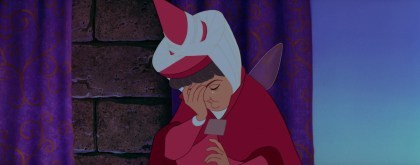
Stupid onions, stupid stupid onions…
Fauna and Merryweather can’t even begin to imagine how heartbroken Stefan and Leah will be, but Flora has a solution: put the kingdom to sleep along with Aurora until she is woken up. I understand her wanting to spare Aurora’s family some pain, but conking out an entire principality for god knows how long to cover up their failure? AND at a time when Europe was all about invading and conquering itself? Are we sure this isn’t just part of Maleficent’s overarching plan for revenge? This sounds more like something she would come up with instead of the leader of the good guys.
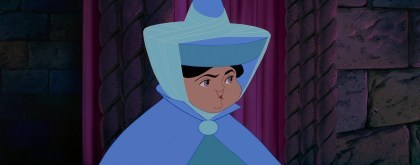
“So what happens if one of the neighboring kingdoms decides to attack while everyone’s sleeping?”

“Then we’ll put them and their armies to sleep, too.”

“And once Aurora is saved, both kingdoms will immediately wake up to find themselves thrust into a war they’re barely prepared for, is that correct?”

“Oh, you’re right, that’s a terrible idea.”

“Finally, thank you.”

“I’ll just turn them all into flowers.”

“THAT’S NOT AN OPTION!!!”
The fairies flitter about the castle grounds spreading their spell over the unwitting royal court, even putting the candles and sconces out. We have another reprise of the “Gifts of Beauty and Song” chorus now altered to sound like a lullaby, providing an interesting bit of symmetry between it and its earlier use in the film. Whereas it first underscored their blessings upon Aurora, now it plays as the fairies are giving the “gift” of sleep to the entire castle.
While Flora knocks out the throne room, she overhears Hubert muttering about Philip eloping with a peasant girl and she makes the connection. The fairies speed to the cottage just as Philip arrives there. But once again Maleficent beats them to the punch. Her goons ambush Philip and she watches them wrestle and bond him with fiendish glee.
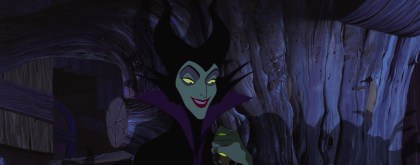
You magnificent, kinky bitch.
Maleficent was only out to capture the one man who could break Aurora’s curse; the fact that he’s really the son of her nemesis’ allies is just icing on the cake. Flora, Fauna, and Merryweather resolve to rescue him from Maleficent’s fortress in the Forbidden Mountain.
Some movies reach the brink of greatness only to falter when it comes to the final act. Sleeping Beauty is not one of them. Everything that happens from the moment we slowly zoom in through the purple mist on to the Forbidden Mountain itself up until the storybook closes is perfection. The perfectly paced action, the animation, the music, Maleficent’s hideaway in all its decaying glory (I swear it’s like Jean Cocteau meets Frank Frazetta meets Giotto) all make for the climax of climaxes.
The fairies shrink to insect size and silently sneak through Maleficent’s creepy domain, narrowly running into guards and gargoyles at every turn. They traverse the stronghold until they find her overseeing a hellish bacchanalia in honor of her supposed victory.
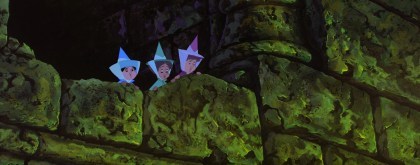
“My old gaffer would have a thing or two to say if he could see us now.”
Soon Maleficent gets bored and goes to “cheer up” her captive. Then we have it: The Moment.
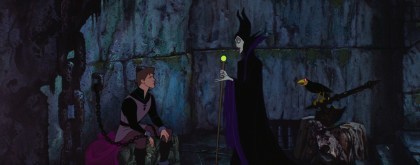
I’ve talked about this before, that one small, devious step further the villain takes to make themselves more heinous in our eyes. It’s the Wicked Witch taunting Dorothy with visions of Aunt Em. It’s the Beldam hanging Other Wybie’s remains. It’s virtually everything Heath Ledger’s Joker does. And it is this simple scene where Maleficent details what she plans to do with Philip. She spins “a charming fairy tale come true” of Aurora sleeping without aging, waiting for her prince to come to wake her. And Philip will escape the dungeon, ride to her rescue and prove true love conquers all – in one hundred years, when he’s a broken old husk of a man on the brink of death. DAMN. If you want to know why Maleficent is considered the best of all the Disney villains, it’s not just all her previously praised qualities, it’s her sheer sadism and the pleasure she takes in it.
The fairies enter and free Philip once Maleficent departs. The course of true love never runs smoothly though, so they arm him with the Shield of Virtue (licensed by Carefree Maxi-Pads), and the Sword of Truth to aid in his escape.
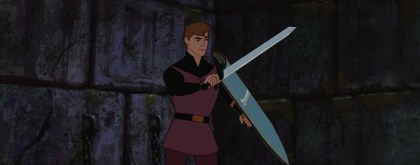
“So, why’s it called the Sword of Truth?”
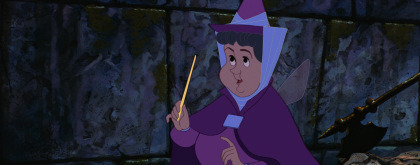
“Anyone who’s subjected to it speaks only the truth…as they bleed out and die, of course.”

“Cool, cool. On an unrelated note, I think I’m gonna go to DC for my honeymoon.”
Diablo sounds the alarm and the Battle With the Forces of Evil kicks off with Philip slashing his Sword of Truth through Maleficent’s goons.
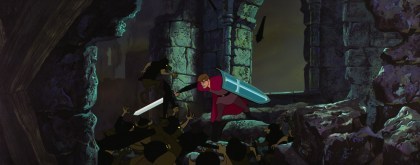
“I steal lunches from the break room fridge!” “I broke wind last Tuesday and blamed it on the dog!” “I cried like a little girl during The Good Place finale!” “I only wash my hands for NINETEEN seconds at a time!”
Philip makes his getaway on Samson and the music reaches truly operatic levels as Maleficent does everything in her power to end him. Yet Philip soldiers through it like a boss. Crumbling mountainsides, Maleficent hurling lightning from the sky and summoning a forest of thorns to block the way? Fuck that shit, he’s gotta go save his girl.
Then, as Philip cuts his way through the briars, Maleficent looks at her watch, realizes it’s No More Fucking Around O’Clock, zooms over to the castle, throws down the most intimidating challenge ever –

“Now you shall deal with me, O Prince, and all the powers of HELL!!”
– and with that, she takes her final form: a massive fire-breathing dragon.
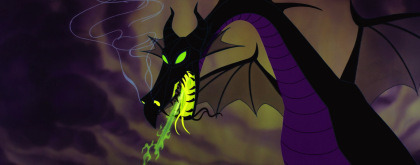
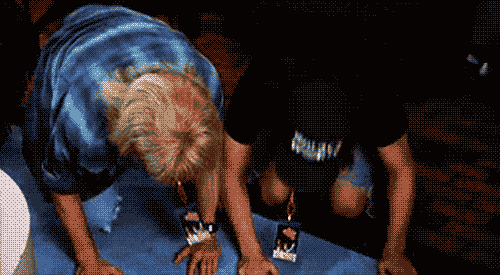
Every Disney villain who’s gone kaiju in the final act owes everything to this gorgeous terrifying beast. The dragon is an awe-inspiring unholy fusion of style, power and darkness. There’s a reason why she’s the final boss in Fantasmic; the chance to watch a live dragon battle is too cool to pass up.
Speaking of battles, Maleficent’s dragon form was animated by Woolie Reitherman, who previously brought us such gargantuan monster clashes as the T-rex brawl in Fantasia and the escape from Monstro The Whale in Pinocchio. And when you have a dragon confronting a fairytale prince, well, you know what’s coming.

Maleficent backs Philip on to a cliff surrounded by flames, leaving him only one desperate shot. With a little extra magic from the fairies, he throws his Sword of Truth at Maleficent and it plunges right into her heart.
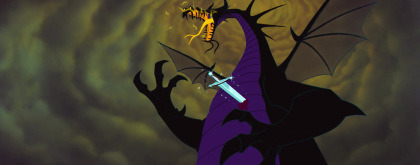
“I liked…Frozen 2…more than the first one…”
Maleficent’s spells die with her, clearing the way for Philip. He gives Aurora that wake-up smooch and everyone in the castle slowly rouses, owing their inexplicable simultaneous twenty-minute blackout to the unusually strong wine.
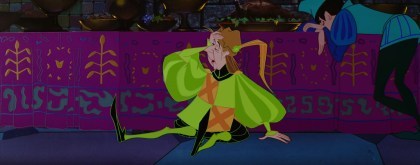
He can attest to that fact.
The royal families are happily reunited, and the film ends on Flora and Merryweather fighting over Aurora’s dress color yet again as she and Philip waltz together on the clouds using animation Beauty and the Beast would borrow thirty-two years later.
Sleeping Beauty is a movie I can never have on in the background because the moment I look up from my work I am spellbound by it. Do I need to elaborate on how this is one of the most beautiful looking and sounding movies Disney’s ever produced? Sleeping Beauty is the swan song of Disney’s first golden age of animation. For better or for worse, their animation process would switch to the rough, cost-cutting Xerox process starting with their next feature, 101 Dalmatians, and few films would reach Sleeping Beauty’s level of gorgeousness ever since.
Though a massive financial and critical hit on release, it wasn’t enough to make up for the monstrous production costs, not unlike Fantasia. Thankfully, home video sales revived interest and made it Sleeping Beauty of the top-selling VHS tapes of the decade, cementing it as a bonafide classic. It’s one of my favorites from Disney for its stunning visuals, gorgeous music, phenomenal villain and overlooked but great cast characters. Revisit it if you haven’t already.
Thank you for reading! If you enjoyed this review, please consider supporting this misfit on Patreon. Patreon supporters receive great perks such as extra votes for movie reviews, movie requests, early sneak-peeks and more! Special thanks to Amelia Jones, Gordhan Rajani and Sam Minden for their contributions!
Artwork by Charles Moss.
Screencaps from animationscreencaps.com
March Review: Sleeping Beauty (1959) Whenever I discuss Sleeping Beauty with someone who doesn't share my enthusiasm for Disney, they have an irksome tendency to get it muddled with Snow White; their excuse being "it has the same plot".
#2D animation#angelina jolie#animated#animated feature#animated movie#animated movie review#animated musical#animation#animator#animators#anthropomorphic animal#aurora#ballet#barbara luddy#battle#battle to end all battles#battle with the forces of evil#bill shirley#bill thompson#blue#briar rose#cake#charles perrault#classic disney#curse#diablo#Disney#disney animated#disney animated feature#disney animated movie
29 notes
·
View notes
Text
Charles Lindbergh - SLI (ISTp)

Delta Quadra: The Quadra who fears “clipped wings” (Stratiyevskaya)
For Lindbergh, the sky was not the limit. As is typical of Delta Quadra, personal growth and development was a lifelong goal of his. He felt the most free when he could fly, and desired to live a quiet, peaceful life close to nature where he could develop his abilities and see and experience new adventures. He hated being part of crowds, hated fast-paced lifestyles. He wasn’t actively trying to change the world; he was simply pursuing what he loved and trying to maximize his own personal abilities, as is typical for Delta Quadra. He was happiest when he felt close to nature, with the freedom to pursue possibilities and develop his own potential. IP type: “IPs are both dynamic and irrational, so they see reality as in continuous, gradual, often imperceptible change.” (sociotype.com). Lindbergh was comfortable with abrupt changes. He was flexible, adaptive, and took things as they came. He saw the world as constantly being in a state of change, as can be easily seen from his writings.
Temperament: Melancholic - “These are sociotypes that are calm externally, but restless inside. Melancholics are introverts, so they hide their inner experiences under the guise of calm or, conversely, liveliness. The problem of any melancholy is the search for inner harmony, which is so easily destroyed by the rude influences of external factors.” (socionic.ru) Though Lindbergh appeared calm on the outside, it can be seen especially from his diary writings that he was internally restless, with a vast depth of inner experiences.

Lead function: Si (4D, Valued) Lindbergh’s love of aviation and flying stemmed from the physical experience it gave him. When describing his first experience jumping out of a parachute, he said, “It was a love of the air and sky and flying, the lure of adventure, the appreciation of beauty.” He was captivated by natural beauty, and cherished the sensations and experiences his pursuits gave him. He loved being alone out in the wilderness, which he often says gave him an unparalleled freedom. He said, “In the wilderness I sense the miracle of life...” He also noted that “The human future depends on our ability to combine the knowledge of science with the wisdom of the wilderness.” Lindbergh was very aware of the environment around him, the harmony within it, and how it made him feel. “Man must feel the earth to know himself and recognize his values...” He desired to preserve the natural beauty of the world. He had a deep love of nature, believing that modern cities were against the nature of man. “Real freedom lies in wilderness, not civilization”, he said. To Lindbergh, it was important to become united with the earth, to melt into it, and to fully experience the natural beauty it had to offer. He became a conservationist and promoter of environmental causes, once mentioning that he preferred birds to airplanes. Toward the end of his life, he planned his funeral and desired to have as natural a burial as possible.
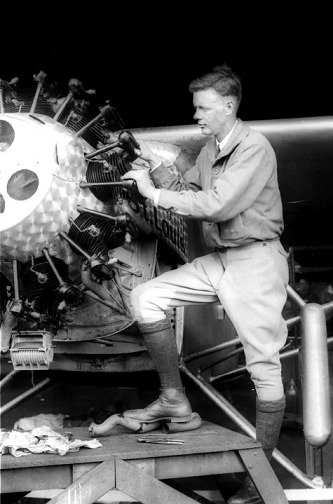
Creative function: Te (3D, Valued) Lindbergh had natural skills as a mechanic. He went to school to study mechanical engineering and originally intended to pursue it as a career, but as can often happen with SLIs, he did not finish and dropped out to pursue flight school instead. However, he was always interested in engineering and performed all the mechanical work on his planes himself. Later on, in 1935, he helped to develop the world’s first “artificial heart”, a heart perfusion pump (valued Te-Ne). He was impressed by the high quality engineering that he saw in Germany (Te-Si-Ne) and their more advanced development of technology. While assisting with altitude tests at the Mayo Clinic, the new information he came up with at the end of his trials there was used by Henry Ford to modify the oxygen equipment of his airplanes and helped them become safer. He also taught young pilots how to best conserve plane fuel and resources so that they could fly for longer periods of time.

Role function: Ni (2D, Unvalued) Lindbergh was grounded in the world around him and was not very imaginative, but he was capable of occasionally turning his attention to the flow of time and long-term implications, and this seemed to be something he desired to do. This can be seen most easily in his writings. According to Model A, the role function is “seen as somewhat of an importance to the individual, but definitely not emphasized.” Model A also notes that “the role function is triggered situationally, when individuals are met with situations that oppose their base aspect of reality.” Lindbergh preferred experiencing things and was never a natural writer. This may be why use of Ni can be seen most easily in Lindbergh’s writings. He wrote that, “Life is a culmination of the past, an awareness of the present, an indication of a future beyond knowledge...” And also said, “I hope my journals relating to World War II will help clarify issues of the past and thereby contribute to understanding the issues and conditions of the present and future.” He made some effort (especially after being encouraged by his wife) to document what he did, to serve as a reminder of the past for future generations, though this was not his primary motivation in life.
Vulnerable function: Fe (1D, Unvalued) It is well-known that Lindbergh hated large crowds and the attention that fame brought him. He was known to make extreme efforts to avoid people and recognition, such as disguising himself when going out in public. When a large crowd gathered to celebrate his landing, he would make efforts to avoid them. He didn’t like all the attention and disliked attempts to bring him into wider society. He rejected offers to be in movies and commercials. Instead, he strived to live a secluded, private life away from the public eye. Even while working on the development of the heart perfusion pump, he desired to be anonymous and keep his work quiet. He seemed to receive no joy out of the prevailing emotional atmosphere. Instead, he would seek to escape such atmospheres, and saw the attention of the public as “oppressive”, remarking that he “had enough publicity for 15 lives.” His avoidance of larger society and desire to do everything on his own in a self-sufficient way helped earn him the nickname ‘The Lone Eagle’.

Suggestive function: Ne (1D, Valued) Lindbergh spent his whole life unconsciously seeking adventure. As a boy he spent a lot of his free time reading, especially adventure stories. The desire to have new experiences, to see new places, was one of the main motivators behind his aviation pursuits. He quit traditional school to pursue flight school, which he thought could lead him to greater adventure. He loved flying to new places and seeing new things. He also had a respect and love of science, discovery, and innovation. He helped the Aero Medical Unit for Research in Aviation Medicine at the Mayo Clinic. When describing the atomic age of war, Lindbergh expresses his sadness over the potential destruction of nature that the atomic bomb can produce. He says, “I worshipped science. I was awed by its knowledge...Now...I have seen the science I worshipped, and the aircraft I loved destroying the civilization I expected them to serve, and which I thought as permanent as the earth itself.” Here we can again see not only his valuing of Te and Ne, through his love of science and knowledge, but also his preference for Si over Se. He disliked the powerful force of the atomic bomb disrupting the harmony of civilization. He was open to new ideas and encouraged their growth and development. He became very interested in space travel and saw space as the new frontier. He supported the rocketry research of Goddard and Guggenheim and secured funding for their projects. Lindbergh also seemed to have an admiration for people with a wide variety of talents and abilities, and desired to develop his own abilities. For example, he admired his wife’s ability to write and speak different languages. She encouraged him to develop his own writing abilities, and this is something he appreciated and responded well to. Mobilizing function: Fi (2D, Valued) The mobilizing function tends to manifest as something we appreciate and that has a strong influence over our actions (School of Associative Socionics, 2020). This can be seen throughout Lindbergh’s life. He stated that, “Power without moral force to guide it invariably ends in the destruction of the people who wield it. Power...must be backed by morality...” During his time as a civilian observer in the Pacific, he wrote about the cruelty and inhumane treatment of the Japanese that he witnessed, and the view among some of the soldiers that the enemy troops were merely “animals”. He said, “I am shocked at the attitude of our American troops. They have no respect for death, the courage of an enemy soldier, or many of the ordinary decencies of life.” He criticized the dehumanization of enemy troops and said he was concerned by the “lack of respect for even the admirable characteristics of our enemy.” He believed in the dignity of the human person, noting that “No person with a sense of the dignity of mankind can condone the persecution of the Jewish race in Germany.” Lindbergh was also known to be a private person who did not talk much of his feelings, and did not like it when others tried to get him to. According to Stratiyevskaya, “SLI dislikes it very much when intimate things are talked about directly - this is almost like a sacrilege to him.” His wife Anne notes that “he himself never felt the need to explain his feelings about where he stood and about past statements.” He disliked any attempts by others to analyze his soul. According to Grigory Reinin, SLIs “try to protect their emotional sphere from the intruding outsiders in every possible way.” He rejected books that were written about him and wanted the only information about him to be written by himself. He regularly kept a diary, but his Te style prevailed over personal Fi sentiments. Much of his diary writings were objective facts rather than personal emotional experiences. Interestingly, he also had a tendency to record the exact number of words on each page and wrote that number at the top, as a statistic.

Ignoring function: Se (3D, Unvalued) Lindbergh was outspoken against war and preferred not to fight, though he understood it as sometimes necessary and showed respect for enemy troops (valued Fi also present). He said, “If I must fight, I'll fight; but I prefer not to spit at my enemy beforehand.” He understood the value of war and combat, but he did not like it to be used unless absolutely necessary. He did not think the US had a right to interfere in the affairs of other countries. He was publicly outspoken against the pro-war policies of President Franklin Roosevelt and it is known that the two of them did not think favorably of each other. He spoke of the misuse of power as being the greatest threat to mankind, and in 1945 said, “History is full of its misuse. There is no better example than Nazi Germany.” He preferred to appreciate and experience nature for what it was, rather than use force to try to conquer and shape it into something else. His wife Anne also noted that “he never wanted to be regarded as a hero or leader, and he never had political ambitions.” She noted that his speeches and statements were given out of his sincere belief of what was the best thing to do for the country and the world. Demonstrative function: Ti (4D, Unvalued) According to Grigory Reinin, for the SLI “knowing the world is its practical mastering.” We can see this with Lindbergh, who was more interested in experiencing life as it was, rather than trying to fit everything into a logical system. According to Wikisocion, SLIs “tend to feel that life is difficult to categorize and should simply be experienced for what it is.” However, this function is a strong, fundamental part of SLIs and could be seen playing a role in his love of science and his mechanical understanding of planes and gadgets. Though Ti is a strong function that is always working in the background, SLIs use it only situationally, to apply it to things they are interested in. Lindbergh had a strong understanding of how things fit together into a cohesive whole, but he chose not to focus on that and preferred experiencing things.
8 notes
·
View notes
Text
Heliogen Achieves Solar 'breakthrough' That Would Exchange Fossil Fuels In Some Industries -.
Throughout summer time months, excessive temperature ranges (especially during heat weaves) will lower the solar system’s performance. The excessive effectivity solar photovoltaic panels accessible on the market today are made by respected corporations that use the most recent technology, have first-class engineers, and supply high degree of quality assurance. This results in extremely low failure charges top quality solar panels and their Panasonic N 330W panel has an efficiency of 19.7 percent. They can also be utilized for smaller scale purposes, and the size of the panel varies in keeping with the mission. It may be harnessed in all areas of the world and is accessible every day. When you've got sufficient space around your own home or on the roof, then cheaper panels with lower efficiency could possibly be a better alternative since they will produce the same quantity of vitality you want by merely installing extra of them. Furthermore, not only will you be saving on the electricity bill, there is also a possibility to obtain payments for the surplus energy that you just export again to the grid. They are not low cost, however relying in your needs, they'll function a solar-based mostly backup system to remove the necessity for a backup generator.
He will get panels on your home… Click Right here for In-Depth Opinions of The top three DIY Solar Power Home Guides Now! You'll discover a number of other advantages about utilizing solar power when you spend time on doing in-depth research. The monocrystalline solar panels are manufactured by using the Czochralski methodology, with every module created from a single crystal of pure silicon. You will then want an off-grid inverter to transform the DC (Direct Present) electricity saved in the battery bank to AC (Alternating Present) electricity which is extra generally used in dwelling appliances. While going solar may seem like the appropriate determination, there are a lot of drawbacks to doing so. Sunworks is your "One-Stop" Residential, Agricultural, and Commercial Solar Integrator that understands there is no "one measurement fits all" solar resolution. Having mentioned this, going solar won't be the precise choice for everyone. You will discover every kind of knowledge which can help you make informed resolution about solar energy and enable you to appreciate the differences it can make in your life. We are able to use the sun’s vitality resources utterly free of cost.
The Solar Energy Trade Creates Jobs
Free Merchandise (Wisconsin)
Our customer support staff reviews your request
Energy adapter
Solar energy is completely free to make use of. Are you prepared to place the sun to be just right for you? An off-grid inverter can convert the DC energy from solar panels and batteries into AC electricity which powers normal appliances. Skinny-movie photovoltaic cells are usually not product of silicon and whereas they obtained the repute as being the least environment friendly out of all different sorts, they're greatest suited to projects that don’t require too much energy but the place flexibility and portability are extra important. How nicely they work depends on how a lot gentle power they get via the solar cells. This process whereby gentle (photo) is transformed into electricity (voltage) is understood because the photovoltaic (PV) effect. Some individuals would possibly even select to take out loans to fund their challenge - a process that might add even more price over time because of the interest paid on the mortgage. Most utility, generation and retail businesses are geared in direction of merely selling extra electrons, or constructing extra poles and wires. California has become the primary state in the nation to mandate solar panels for all new properties, in a transfer to cut greenhouse fuel emissions that critics say will find yourself elevating home prices in the already expensive market.
The original 30% tax credit was alleged to expire at the tip of 2016, before being prolonged for one more three years. The Mission Site consists of three non-contiguous boundaries that encompass approximately 6,350 acres. The new California measure would scale back greenhouse gasoline emissions by 700,000 metric tons over three years, in line with the commission. The most important advantage for having solar power for homes is that it's going to enable you to save tons of money every month. Technology in the solar power trade is continually advancing and improvements will intensify sooner or later. The upfront costs of installing residence solar panels can run into the tens of 1000's of dollars. On a January night, Anand is shelling betel nuts by the sunshine of an electric lamp in Halliberu, his village in India’s Karnataka state. It's because when you produce more energy than what your own home has used, you can sell the additional vitality to the electric firm. For example, wind turbines can create vital ranges of noise pollution.
1 note
·
View note
Text
The Usual Suspects (1995) Final Project
COM 323: Films of the 1990s
Introductory Video
The Usual Suspects (1995) Trailer
youtube
Production
The first inkling of The Usual Suspects film came to director Bryan Singer as he read an article in the magazine known simply as Spy. It was a passage regarding the famous 1942 film Casablanca in which the character of Louis Renault says that they need to, “round up the usual suspects.”

With a title now in mind, Singer and his screenplay writer Christopher McQuarrie could get to work. The screenplay for The Usual Suspects took McQuarrie around five months to create. He had used elements of one of his previous, not published works to forge the story. McQuarrie combined several real-world elements into the film’s screenplay including the true crime story of John List who killed his entire family then took on a new identity for some 20 years until he was caught. According to an article from The Guardian, “A lot of the inspiration for Keyser Söze, the villain, came from the character of Yuri in the 1980s thriller No Way Out – a spy within the Pentagon who may or may not exist.” The name “Keyser Söze” is based on one of McQuarrie’s previous coworker’s name, Kayser Sume. When trying to adjust Sume’s surname, McQuarrie used a friend’s Turkish dictionary to discover the word “söze,” which means “talks too much,” which, in hindsight, is hinted at through Roger Kint’s nickname “Verbal” and his self-admission of being talkative. The name origin also potentially explains why Söze is described as "supposedly” Turkish. Similarly, characters mention that Keyser Söze‘s father might be German. His first name Keyser seems to be a reference to the German word “Kaiser” which means “Emperor.”
Once the screenplay had been completed to Singer and McQuarrie’s liking, they began to show it to studios, hoping to find an interested party. However, that turned out to be much harder than anticipated. Despite the excellent writing by McQuarrie, the vacancy of the cast and non-linear storytelling elements scared off most studios. The film’s rough start is described in “Usual Suspects, Unusual Devices,” by Martin Barker and Thomas Austin. The journal article reads, “It almost didn’t get made. Its director Bryan Singer and writer McQuarrie tried 130 film financiers before finally cutting a deal with two European sources. Even then, the deal almost fell apart just days before filming was due to start, when one backer withdrew. Finally, a recut of the distribution and video rights brought in combined finance from Polygram and Spelling International.” So, they finally found some hope in Europe with the PolyGram film company, though the actors were going to have to be paid significantly less than their usual fees. The actors which they cast were okay with the lower pay, however, as they wanted the opportunity to not only work with Singer’s direction and McQuarrie’s script but also the other actors involved. In fact, in 1993, Kevin Spacey had met Bryan Singer and told him that he wanted to act in Singer’s next production.
The Main Cast - “The Lineup”
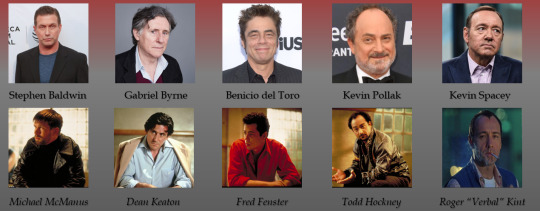
When the film began production, the budget was set at five and a half million dollars. Perhaps due to funding or other factors, there were only three shooting locations for the entire film. These were the cities of Los Angeles, New York City and San Pedro, CA. The film was shot in only 35 days, which is quite short compared to other films. Although it would seem the most prominent issue for the film would be the lack of financial backing, it turned out to be the actors themselves. Director Bryan Singer could not keep his main five actors in character, especially when they were all together like the famous “lineup” scene. Several scenes would take much longer than expected to film due to the actors being unable to stay in character because they would laugh with one another. In the final take of this scene, the characters are seen giggling, this is partially purposeful to show their camaraderie but much of it was the actor’s genuine laughter, particularly during Fenster’s delivery of the line.
The Usual Suspects (1995) “Lineup” Scene
youtube
Another less humorous issue that plagued the shoots was the size of filming locations. They had to film in many confined areas which made the job of cinematographer Newton Thomas Sigel all the more interesting. In order to combat this issue of space, he used creative zoom tactics and dolly movements to simulate motion which made the space feel larger. The film wrapped shooting two weeks prior to its estimated date. However, one day Singer had a feeling that the mystery of Keyser Söze was unfinished. He felt that the film needed to convince the audience that Dean Keaton was Söze to up the ante of the twist ending. From this revelation came one of the film’s most crucial and shocking scenes. The sequence is the one at the very end, where Kujan stares at the board whilst past dialogue looms in the background as he pieces together the mystery. I have attached the video clip below:
The Usual Suspects (1995) Ending Scene
youtube
Marketing
The advertising campaign for The Usual Suspects started off with an unusual issue. The studio executives were worried that audiences would not know how to pronounce “Keyser Söze.” So, they thought a good way to combat this was to create posters and television advertisements which read, “Who is Keyser Söze?”
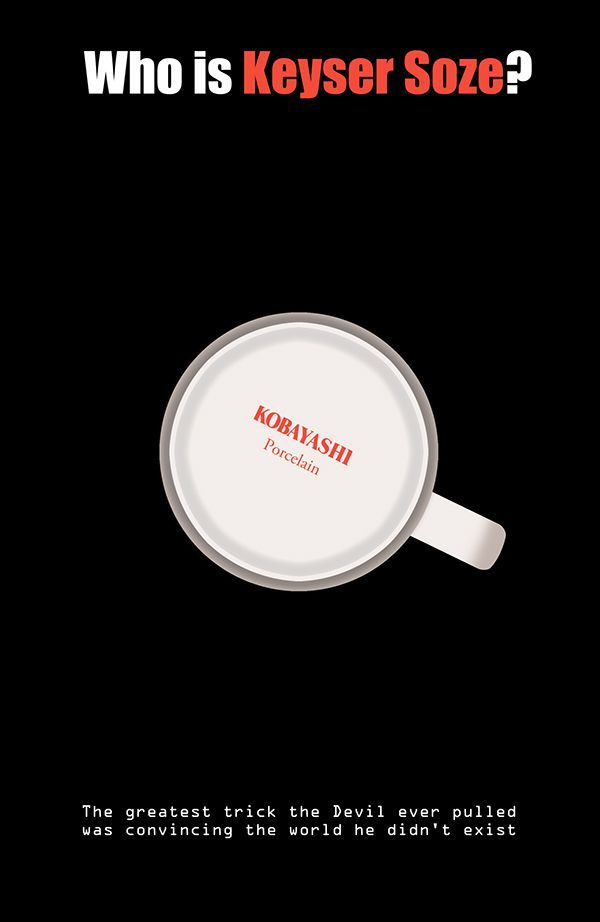
Though, many people still mispronounced it despite their efforts. The film itself initially aired at the now famous Cannes Film Festival in 1995. Here, it was met with a good reception from both critics and fans. Before it could get its full theatrical debut, it was shown in select screenings in Los Angeles and New York City, two of its filming locations and general movie hotspots. After these showings, it was aired in many theaters around the country and grossed around $23 million, which shattered its small budget numbers.
Reception
Despite successful monetary gains from the film, the critical reception after its full release was less than ideal. Overall, most critics felt the film was either predictable, confusing or only created to give its cast Oscar nominations. Famous film critic for the Chicago-Sun Times, Roger Ebert, gave the film a terrible one and a half stars, writing, “The story builds up to a blinding revelation, which shifts the nature of all that has gone before, and the surprise filled me not with delight but with the feeling that the writer, Christopher McQuarrie, and the director, Bryan Singer, would have been better off unraveling their carefully knit sleeve of fiction and just telling us a story about their characters – those that are real, in any event. I prefer to be amazed by motivation, not manipulation.” Other critics gave it similar ratings like USA Today’s two and a half stars. Though there were some outliers at the time, like reviewers for The Independent and The New York Times who gave it positive reviews. One of these reviews was from Lisa Schwarzbaum of Entertainment Weekly, who wrote, “Dense with plot intricacies, thick with atmosphere, and packed with showy roles for a hip ensemble, The Usual Suspects is fun to watch — a celebration of cool actors having a good time playing sweaty and devious lowlifes.” However, her opinion seemed to be in the minority.
Fast forwarding to today’s view, the film seems to have had a shift in opinion. The three most popular film reviewing sites, IMDb, Rotten Tomatoes and Metacritic gave it an 8.5, 89% and a 77, respectively. Notably, the audience score on Rotten Tomatoes is a whopping 96%. Clearly, there has been a change of thought towards the 1995 film over the years. Today, the film is included on many lists of “top” films. Some of these lists include top movies of the 1990s, top crime dramas and even best films of all time. Many even cite this film as a “classic” or a “must watch” which is a sign of remarkably high praise. Some of the more well-known lists it has made were curated by the American Film Institute and the Writers Guild of America. Not to mention, the film has won numerous awards, even back in the 1990s. Some of the most notable awards being McQuarrie’s wins for Best Original Screenplay at the Academy Awards, the BAFTAs and the Independent Spirit Awards. Along with Kevin Spacey’s win for Best Supporting Actor also at the Academy Awards among many others for the cast and crew alike. So, even if the critics did not seem too keen on the film back in ’95, there still were many who supported it enough for them to score such high accolades.

Since the film’s release in 1995, it has found its way into different areas of popular culture through references, homages and other nods to the film. In fact, there was even an official remake in Hindi called Chocolate in 2005. But looking beyond this remake, acknowledgements to the film can be seen all over from a monologue by Stephen Colbert to Family Guy cutaways to Key & Peele skits and perhaps most famously in Scary Movie (2000).
youtube
Many of these come in the form of citing famous lines from the film or re-hashing crucial scenes such as Kujan’s piecing together Verbal’s fabrications or Verbal’s shift from limping to walking normally. Along with loving references to the film, there has been a bit of controversy as well. Actor Gabriel Byrne, who played Dean Keaton, claimed that the film’s production was temporarily halted due to Kevin Spacey’s inappropriate behavior on set. Byrne stated for The Sunday Times, “I mean, he was kind of a joke in that people would say, ‘That’s Kevin,’ but nobody really understood the depth of his predations. It was only years later that we began to understand that [filming] was closed down for a particular reason and that was because of inappropriate sexual behavior by Spacey.” Director Bryan Singer has since spoken out about Byrne’s claims. He denied the allegations against Spacey.
The Neo-Noir Genre
The neo-noir genre is defined by Mark Conrad in his work The Philosophy of Neo-noir as, “...any film coming after the classic noir period that contains the noir themes and sensibility.” The genre is a revitalization of the classic film noir, hence the prefix “neo” which means “new.” These films aim to capture a similar essence to the past noir crime films. They maintain similar characteristics in their writing style, cinematographic choices and essential themes. Some of these themes include crime, mystery, twists, paranoia, vengeance and deception. The way in which neo-noir differs from classic noir is seen through its use of updated technology and tackling of more modern societal problems. These films are also defined by the way in which they approach character. In classic noir, the motivations of the criminal or the detective were typically clear. But in neo-noir there is often a blurred sense of the world, where the character’s motivations are unknown or misunderstood and there is no clear division of good and evil as well as reality and fiction.
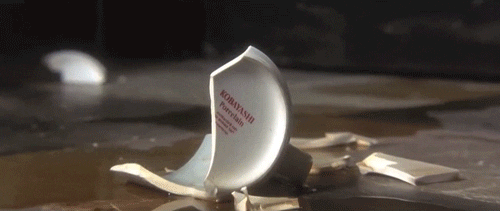
The way in which The Usual Suspect’s plot unfolds and its conflicts are battled perfectly fits the neo-noir outline. Writer J.P Devine describes the film in an article for Central Maine’s website as, “...a game of chess, a masterpiece full of fake clues, twists and turns that flows from light to shadow and back again. ‘The Usual Suspects,’ as most filmmakers know, rests somewhere near the top of the list of the greatest film noir thriller-capers of all time.” First and most obviously, the baseline of the entire film: crime, criminals and police. These three elements defined the classic noir genre at its core and have continued to define the neo-noir predecessor. Next, the film is based around one central mystery who is “Keyser Söze?” Neo-noir cinema most commonly revolves around questions or figures like these who the viewer and the characters will spend most of the film trying to pinpoint their identity. As the viewer watches Kujan stare at the board after Verbal has left the interrogation, both the character and the audience begin to piece together the fabrication of Verbal. As Verbal is seen shifting from limp to upright walk it all falls into place as the real Söze drives off uninhibited. This moment is exemplifying two examples of neo-noir cinematic patterns, the twist and deception. Verbal has fooled everybody, the viewer included. He has fabricated the perfect story to lead everyone off his trail and onto Keaton’s, who is confirmed dead, which means Söze would be too. As Stanley Orr explains in his, “Postmodernism, ‘Noir’, and ‘The Usual Suspects,” “Throughout the course of the film, Verbal installs himself on the periphery as mere documenter, ‘alone returned to tell the tale.’ Seemingly innocuous, Verbal diverts suspicion by focalizing upon Keyser Soze and Dean Keaton. In the last moments of the film, Verbal leaves Rabin's office under a new aspect: his ‘hand flexes with all the grace and coordination of a sculptor's’ (McQuarrie 120).” He has convinced everybody that he – the talkative, limp-footed “Verbal,” does exist while simultaneously convincing that the mysterious, all-seeing crime boss, Keyser Söze, does not, just like the devil.
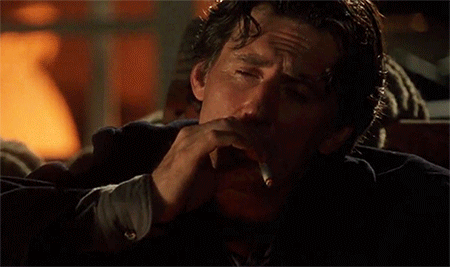
Along with the plot and structure of the film fitting the neo-noir genre, so do the characters themselves. In the journal article, “Rounding up ‘The Usual Suspects’: The Comforts of Character and Neo-Noir” by J.P. Telotte, the author notes, “The Usual Suspects offers an especially telling illustration in this regard, particularly of the impact of character in the neo-noir. It is a film that begins with a mystery and almost literally invites its viewers to play at guessing that mystery, at ferreting out the clues to its narrative and anticipating its twist ending. Moreover, that mystery depends totally on the film's conception and our own orchestrated and convention-driven misconception-of character, a set of reactions that pointedly flies in the face of our anticipation of narrative conservatism and undercuts one sort of pleasure or comfort we have come to expect from our films.” As explained previously, Keyser Söze is a brilliantly written character along with his Jekyll and Hyde-esque counter-part Roger “Verbal” Kint. Both of their motivations seem unclear for most of the film until the twist is revealed. Once they are established as the same character, many of the the motivations for Söze fall into place such as his paranoia that the man on the boat was going to expose him. Hence why he sent the criminals on a wild chase for some non-existent drugs on the ship. He wanted that man to be dealt with without the “lineup” knowing exactly why.
Also, the conflict between good and evil can be seen through both Söze and Keaton. Keaton’s struggle is more obvious and active throughout the film. He wants to escape the life of crime and live a morally and legally “good” life with his girlfriend, however, he finds it difficult to fully separate. Over and over he tries but he keeps being pulled right back. He cannot create true division between the good and the evil within himself. Similarly, after Verbal is revealed as Keyser Söze, this conflict comes over the audience. Initially, one feels themselves almost inclined to tip their cap to Verbal for his performance. Despite knowing the crimes he has committed, the viewer cannot fully write off Söze, he tows the line between likeable and truly evil in the minds of the viewer. The way in which the audience finds turmoil in supporting or disdaining his character is comparable to how readers feel about Satan in John Milton’s epic Paradise Lost. Something draws the audience into these characters despite or perhaps because of their wicked ways. In “Usual Suspects, Unusual Devices,” Martin Barker and Thomas Austin explain that, “The Usual Suspects rewards its viewers with the pleasures of unpacking its cleverness, and at the same time it rewards us by enabling us to demonstrate (to ourselves, to film-going friends) our cleverness in deciphering its deceits. It rewards with frissons of delighted shock the terror of a conspiratorial view of the Underworld: an attractive/dangerous stock of appalling characters. It rewards us if we are willing to play with the notion that authority is a mixture of inept and corrupt – but that corruption may be as nothing in the face of an awesome corruption so demonic that the petty authorities who think they run things are just self-deceivers.” His character is the encapsulation of the neo-noir genre’s blurring and bending of right and wrong, of good and evil, of reality and fiction. He lives his life miles ahead of those who wish to unravel his mystery. By the time anyone can wrap their head around his deceit, it is too late because, in devilish fashion, like that... he’s gone.
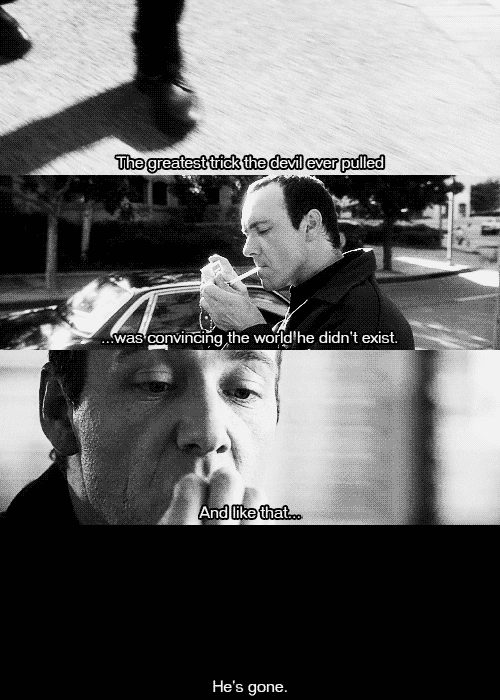
Works Cited
Derschowitz, Jessica. “What Critics Thought of 'The Usual Suspects' When It Came out 20 Years Ago.” EW.com, 16 Aug. 2015, ew.com/article/2015/08/16/usual-suspects-20th-anniversary-reviews/.
Telotte, J. P. “Rounding up ‘The Usual Suspects’: The Comforts of Character and Neo-Noir.”Film Quarterly, vol. 51, no. 4, 1998, pp. 12–20. JSTOR, www.jstor.org/stable/1213240. Accessed 28 June 2020.
Ebert, Roger. “Ebert's Most Hated: Roger Ebert: Roger Ebert.” Roger Ebert | Roger Ebert, www.rogerebert.com/roger-ebert/eberts-most-hated.
Ebert, Roger. “The Usual Suspects Movie Review (1995): Roger Ebert.” Movie Review (1995) | Roger Ebert, www.rogerebert.com/reviews/the-usual-suspects-1995.
Gelly, Christophe. “The Usual Suspects or the Potency of Falsity.” Mise Au Point. Cahiers De L'association Française Des Enseignants Et Chercheurs En Cinéma Et Audiovisuel, Association Française Des Enseignants Et Chercheurs En Cinéma Et Audiovisuel, 1 Apr. 2014, journals.openedition.org/map/1646?lang=en.
Hoad, Phil. How We Made The Usual Suspects. 4 Jan. 2016, www.theguardian.com/culture/2016/jan/04/how-we-made-the-usual-suspects-bryan-singer-gabriel-byrne
Schwarzbaum, Lisa. “The Usual Suspects.” EW.com, 25 Aug. 1995, ew.com/article/1995/08/25/usual-suspects/.
Sharf, Zack. “'The Usual Suspects' Reportedly Stopped Filming Due to Kevin Spacey's 'Sexually Inappropriate Behavior’.” IndieWire, IndieWire, 5 Dec. 2017, www.indiewire.com/2017/12/usual-suspects-kevin-spacey-sexual-misconduct-bryan-singer-1201904039/.
Travers, Peter. “The Usual Suspects.” Rolling Stone, Rolling Stone, 25 June 2018, www.rollingstone.com/movies/movie-reviews/the-usual-suspects-93781/.
“The Usual Suspects (1995).” Rotten Tomatoes, www.rottentomatoes.com/m/usual_suspects.
1 note
·
View note
Photo

517: Beginning of the End
When I think of the kind of movie that belonged on MST3K, Beginning of the End checks all the boxes: it’s got a silly premise, a lousy script, bad acting, laughable special effects, obvious stock footage all over the place, continuity errors galore… and of course, Bert I. Gordon, the garbage king of bug movies! I couldn’t possibly ask for more, whether I’m watching with Mike and the bots or all on my lonesome.
Somehow the town of Ludlow, deep in the mountains of Illinois (this movie takes place in an alternate universe), has been utterly destroyed overnight! Reporter Audrey Aimes takes up the story and it leads her to a lab where Dr. Ed Wainwright and Dr. Frank Johnson are using radiation to grow giant vegetables. Turns out, a swarm of locusts ate some of the super-crops, causing them to grow to enormous size, and now they’re on the move looking for prey! Will the government be forced to nuke Chicago in order to destroy them, or can Wainwright and Aimes find another way before it’s too late?
Wikipedia has far more information on how they worked with the insects in this movie than I ever wanted to know. Apparently Gordon bought a box of grasshoppers from Texas, after some poor bastard from the Department of Agriculture carefully went through all two hundred or so to make sure they were all males and therefore couldn’t breed. Then I guess somebody forgot to feed the bugs on their way to California, because they ate each other. The reason you never see more than a handful in any given shot, despite the characters talking about swarms of the things, is because those were the battle-scarred survivors.
The idea of growing giant food in order to end world hunger is something I’ve seen in a couple of different movies from this era, and it always makes me snicker a little. For one thing, it’s misguided: people don’t starve because there’s not enough food, but because either they can’t afford it, or it can’t get to them. For another, it’s monstrously impractical: what are you going to do with a tomato that looks like it should be sitting outside a Target? How will you transport it? What will you make with it? What happens to the leftovers?
My theory is that Wainwright said ‘end world hunger’ in order to secure funding – his actual motive is simply to grow bigger tomatoes, perhaps to show up some neighbor who took home a prize at the county fair every year and then gloated about it, no matter how hard the Wainwright family worked on their garden. I like this idea because it lets me picture Peter Graves bent over a Mad Scientist Kool-Aid Bar, muttering things like, “I’ll show you, Mr. Williams. I’ll show you.”
Leo G. Carroll, on the other hand, just really liked tarantulas and wanted one big enough to sleep at the foot of the bed.
Time to talk about the actual movie, though. It’s got a number of things in it that I really like. For one, there’s no drawing out of the ‘nobody believes in the giant grasshoppers’ thing. In a lot of movies, the soldiers sent to investigate the grain elevator would have found nothing at all. In The Beginning of the End, they encounter giant insects almost right away, saving us from a lot of pointless dawdling around. I can think of half a dozen movies that would have done well to follow this example! Their plan to destroy the giant bugs is pleasantly free of technobabble or bullshit like ‘mesonic atoms’, though I would dearly like to know how they actually captured that giant grasshopper and got it into the building. The script also gets around the problem of a monster that can easily be heard coming by establishing that victim Dr. Johnson is deaf. No Tiptoeing Tyrannosaur Syndrome here!
Furthermore, both the disabled Johnson and the woman-in-a-man’s-job Aimes are mostly treated with respect – even the military men standing in Aimes’ way remark on how she’s at the top of her field. Captain Parker invites her to hang around because he trusts her to make the army look good in a situation where they could easily be accused of shady dealing and coverup. Johnson and Wainwright have their own separate areas of expertise and each pays attention to what is appropriate for his, and Johnson’s disability never gets in the way of his job. The dialogue implies that Wainwright went out and learned sign language just so he could continue working with Johnson after his accident, which speaks eloquently to the depth of their bond without any clunky lines about how ‘he’s also my best friend’.
The mental image I described above, of Graves muttering over his revenge tomatoes, sounds pretty mad-sciencey, doesn’t it? That’s another kind of neat thing Beginning of the End has going on – the character of Ed Wainwright actually fits the part of mad scientist very well. He’s a man working in secret in the middle of nowhere with a disabled assistant. They Tamper in God’s Domain, creating things nature never intended, which escape their control and run off to break stuff. That could be a description of Victor Frankenstein, in his lonely castle making a monster with Igor the hunchback! Beginning of the End tones everything in the scenario down from the gothic to the everyday, the castle to a garden shed and so forth, but all the elements are still present, and nobody is more aware of this than Wainwright himself. When asked if he ‘bred’ the locusts, he replies, “in a sense, I did.”
The difference is in how Wainwright responds to the monsters he has created. Dr. Frankenstein is so horrified by what he has made that he disavows all responsibility for it. Wainwright, on the other hand, immediately steps up and takes responsibility. Throughout the rest of the film we see that he feels keenly responsible for the existence of the grasshoppers and for every single life they take – not only his friend and partner Dr. Johnson, but complete strangers as well. If the army is forced to nuke Chicago, he will consider this, too, his own fault. He stays in the city not only in the hope of finding a solution, but because he truly believes that if Chicago has to go then he deserves to go with it.
I like this idea, of a mad scientist realizing he’s a mad scientist and trying to deal with it. It’s got a Manhattan Project, I am become Death vibe to it that could have been really interesting and relevant to the 50’s Atomic Age zeitgeist. Sadly, I think it comes far more out of how Graves plays the character than how Fred Freiburger and Lester Gorn wrote him. The biggest problem is that none of the other characters recognize Wainwright’s self-destructive guilt for what it is. Aimes, who is supposed to have fallen in love with him, offers to stay in Chicago at his side until the bitter end – I think this is supposed to be a romantic ‘die-in-each-other’s-arms’ gesture, except that mutual suicide is not romantic and a far more caring and natural thing to do would be to find this man a therapist!
What Bert I. Gordon himself actually seems to have been trying to accomplish was adapting H. G. Well’s The Food of the Gods and How it Came to Earth. I suspect this was Gordon’s favourite book – he would use it for inspiration again in 1965’s Village of the Giants and 1976’s Food of the Gods. In the book, scientists create a ‘superfood’ that causes anything that consumes it to grow to six or seven times normal size – unfortunately, this effect is passed on to anything that eats the giant animals and plants, and so forth. Wells’ book was social satire, exploring the problems created by unchecked population growth in Victorian England. Gordon, however, is much more interested in the story's relatively minor motif of an infestation of giant pests, and in his favourite bit of movie magic, making small things look big.
Beginning of the End does note that the grasshoppers aren’t the first bug to get into the experimental farm, and this makes me wonder if he had a series of sequels planned. If so, it’s a pity he didn’t get to make them. I would give blood to see that giant snail movie.
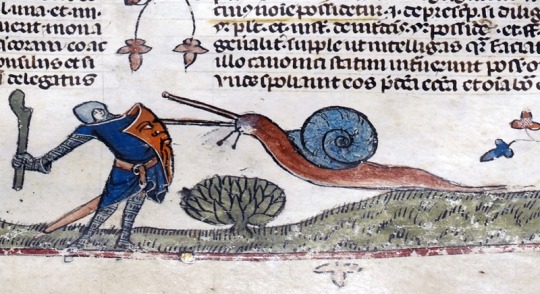
As an attempt at a good movie, Beginning of the End tries some interesting things and even though it fails you can see enough of the outlines to have an idea what it was getting at. As a bad movie, it succeeds spectacularly! Despite what Dr. Forrester said about it picking up just before the end, it’s not badly-paced. The opening sequence with the destruction of Ludlow tries to create a sense of mystery, and once the clues are lined up it doesn’t waste time on people not believing in what the audience has already seen. There’s lots of grasshopper action and it’s all appealingly ridiculous. The one that wanders off the side of a building into empty space is a classic, but there’s also that ludicrous moment when the grasshopper appears to be spying on the woman who just got out of the shower. Nor can we forget poor Dr. Johnson trying to scream as the giant bugs close in on him!
Beginning of the End is everything I enjoy about Bert I. Gordon movies. It’s made with love, by people who are terribly proud of what they’ve created even if it really didn’t amount to much. I honestly don’t think Gordon cared whether his movies got good reviews just so long as they entertained people. Some filmmakers whose work as featured on MST3K, like Joe Don Baker or Sandy Frank, were bitter about it for years, but I suspect Gordon absolutely loved that the show brought his work to a bigger audience. I really need to get on with seeing more of his stuff for Episodes that Never Were, and I hope it features in Season 12, as well.
#mst3k#reviews#beginning of the end#tw: suicide#that guy from the university of minnesota#mister big#50s#giant arthropod hours
39 notes
·
View notes
Text
Review: Jurassic World: Fallen Kingdom
NOTE: I actually saw this movie in theaters but since it’s DVD release was yesterday I figured I’d post my review of it here. I might ramble on for several paragraphs in these reviews, especially if I feel strongly about something, so I’ll try and make it a point to post a short rating at the top as well as a more in depth one at the end.
NOTE THE SECOND: I don’t usually care about spoilers in these reviews so read at your own risk.
1 out of 5 stars. Only watch on Netflix if you exhaust all your other options.
Jurassic World: Fallen Kingdom is written by Colin Trevorrow (previous writer and director of the last entry in the franchise) and Derek Connolly and was directed by J.A. Bayona. Chris Pratt and Bryce Dallas Howard reprise their roles as Owen Grady and Claire Dearing respectively and are sent back to Isla Nublar by Jon Hammond’s previously never mentioned before former partner billionaire Ben Lockwood played by a James Cromwell who can barely bother to keep his eyes open throughout the movie. I, in fact, share that same sentiment.
Usually in these reviews I try to touch on all the aspects of said medium: visuals, camera work, writing, directing, acting, etc. But this review is going to focus mainly on the writing and acting because both are so atrocious all the other aspects are inconsequential.
I didn’t think the first Jurassic World (JW) was as great as it needed to be for a soft reboot / revival of such a beloved franchise but it did have several memorable moments. The leads were charming enough to make you forget that they lacked meaningful character arcs (Claire does have one but the movie doesn’t care about it that much) and the action in the second half of the film was pretty cool (specifically T-Rex and Raptor and Giant Alligator Thing vs. the Indominus Rex). So for the second go around I was hoping that the filmmakers would take the time to really get it right and do the franchise justice. My hopes were far too high.
The only two performances that were worth anything in Fallen Kingdom (FK) were the two returning leads, Pratt and Howard. Howard is a decent enough actress but I’ve never seen a performance from her that I really love and FK continues that trend. Claire does undergo a change from shrewd, cold businesswoman to animal rights activist and that does give some depth to her character but it happens off screen during the three years between JW and FK. It was a little jarring at first but I swallowed it better when the film took a minute to explain her motivations. Pratt was as Pratt as ever as Owen is exactly the same through this movie as he was when we first met him in JW. I fear there’s a real risk for Pratt here as it seems as though he’s becoming another Will Smith or Tom Cruise. He is varying degrees of his usual charming and charismatic self in whatever project he appears in. Owen is just Pratt but outdoorsy to the extreme. Star-Lord is just Pratt with his ego turned up to eleven. Andy from Parks and Rec is just Pratt as a dumb man-child. And I guess that’s fine. Plenty of stars have made careers doing the same but actors actually stretching themselves and challenging themselves to become someone else will always be more impressive.
One thing that annoys me about modern blockbusters are their tendencies to inject new secondary characters into each following installment while completely ignoring the B cast from the previous entry. In the original Jurassic trilogy it did make some sense to do that as each sequel followed the branching lives of Ian Malcolm and Allen Grant who, we can presume, never encounter one another again after the first film. But here there’s little justification for it. JW’s comic relief characters Lowery and Vivian, played by capable comedy actors Jake Johnson and Lauren Lapkus respectively, are nowhere to be seen in this movie. Instead we have Franklin Webb, a spazzy tech guy played by Justice Smith, and Zia Rodriguez, a ball busting veterinarian played by Daniella Pineda. I don’t have much to say about Pineda, she was decent enough and served her purpose, but Smith … Oh my God. I believe this guy will go down in history as the absolute worst character in any Jurassic movie ever. Yes, he is even worse than every child character in all of the movies combined. He does nothing for the movie other than to scream in a high pitched voice when something scares him. Everything scares him. It’s always played for laughs but the joke falls flat on its face every time. The movie thinks it’s funny for a grown man to shriek in terror and scream out loud the thing that’s scaring him. “Lava!” “T-Rex!” “Social interaction!” All right, I made up that last one but the character is so cliché he might as well have said it. And what’s more there is no reason for this character to be here. The movie wastes a fine opportunity to bring back JW’s Lowery who was also a tech guy. In fact it even makes sense for him to run with Claire in her animal rights activism as he was a huge fanboy for Jurassic Park. He had toy dinosaurs all over his work station, he loves them! And it makes even more sense for him to return to Isla Nublar because he was familiar with the park’s computer systems. Why isn’t he joining Claire? He was courageous and had some genuinely funny interactions with Vivian. He certainly would have been better than Spazzy McScreamy.
Speaking of trends let’s talk about the obligatory child character. Isabella Sermon makes her big screen debut as Maisie Lockwood, Ben Lockwood’s granddaughter. Of all the new additions to the franchise she’s the standout as her performance has a depth and range most child actors would struggle to convey. Now one thing about the Jurassic movies is that their child characters were usually pretty capable in some way or another. Hammond’s granddaughter in JP reboots the computer system. Malcolm’s daughter in Lost World is able to gymnastic a raptor to death (yeah it’s a dumb scene but she saves her dad). The teenager in JP3 survives Isla Sorna alone for eight weeks. And the brothers in JW are able to fix a derelict jeep and rescue themselves. FK started out following this trend of capable children with Maisie … until it abandons the idea so we can have a “monster creeping through a child’s bedroom” scene. This completely undermined her whole character. Up until then the movie had established her as smart and independent and capable as hell. She snuck into the secret lab, spied and hid from the bad guys, busted out of her room which she’d been locked in, and climbed atop buildings all secretly by herself without help from a single grown up. But the minute the new hybrid dinosaur goes after her, which she had seen several times before then, she immediately forgets how capable she is and hides under her bed sheets. This might be the most heinous example of bad writing in this whole movie. Mixed messages? Okay, fine. Forgettable action sequences? Whatever, that’s most of Hollywood anyway. But please, for the love of God, have consistent characters!
Now the villains. Ugh.
BD Wong returns as the dastardly Dr. Henry Wu, the mastermind genius behind the dinosaur cloning process, the I-Rex, and FK’s new hybrid the Indoraptor. It would seem that in the three years since JW InGen and its parent company Masrani Global have cut Wu loose as he’s now partnered with a new financier Eli Mills played by Rafe Spall, the CEO / director / executor of Ben Lockwood’s … estate? Company? Trust fund? I don’t remember the movie specifying what Mills’ job was, only that he was another white collar villain (because we haven’t seen that before in a Jurassic movie). Toby Jones makes an appearance as Mr. Eversol, an auctioneer for the high rolling criminal underworld, and Ted Levine plays Ken Wheatley, the leader of a disposable mercenary force who has an odd fetish for collecting dinosaur teeth. And that is literally all there is to the villains. Each of them is cartoonishly shallow to the point that Wheatley is a parody of an archetype and all Dr. Wu needs is a mustache to twirl. True, the villains have never been that big of a deal in the Jurassic movies as the dinosaurs have always been the main attractions but not even Vincent D’Onofrio’s Hoskins from JW was this bad and in a movie full of weakly written characters he was the weakest link.
And let’s not forget the dinosaurs. They are there. Not as much as you’d like but they’re around. The big draw for Owen this time around is to save Blue, the only surviving raptor from the pack he raised and trained, from Isla Nublar’s impending volcanic eruption. FK plays this up as though Blue was always the equivalent of a loyal attack dog but it conveniently forgets that JW established her as a dog capable and willing to bite the hand that fed her. The scene from the previous movie in which Owen is in the raptor enclosure is a tense moment because he is under threat from all the raptors, Blue included. In fact when the I-Rex persuades them to go after the humans all the raptors focus in on Owen. There was that one moment when Owen pulls off Blue’s head camera at the end of JW but to rewrite the relationship as though she were a loyal golden retriever, I feel like that was not earned in the slightest. And the main attraction this time is the new hybrid, the Indoraptor, essentially a smaller version of the previous movie’s I-Rex. FK presents this abomination of genetic manipulation as an ultimate monster but it really just looks like rejected concept art of the I-Rex. Also the Indoraptor is only in half of the movie. The I-Rex in JW was a better monster because it was terrorizing the island for almost the whole runtime. Plus the I-Rex has some decent build up and a good reveal. Here, it feels like the movie couldn’t be bothered. “By the way, we made another hybrid dino. Here it is.” I did enjoy the return of more practical animatronics over every dino being CGI but if you saw the last film this one doesn’t have anything special for you in that regard.
Let’s talk about Trevorrow’s writing. It’s awful. Like a pile of hot rancid garbage awful. The biggest problem with JW is that it completely ignores the moral of the original. JP was a cautionary tale that proves whenever man tries to exert his will over nature he will lose and just because we can do something it doesn’t mean we should. It’s classic man vs. nature ending with man being humbled. JW said, “Hey look, we’re going to keep doing that ethically questionable thing most people believe we shouldn’t be doing and wield the power of a god with no regards to any possible consequences,” and gets upset when the monster it created wreaks havoc. But does FK finally learn that lesson and try to take the franchise somewhere new that doesn’t lead the characters into being idiots who keep going back to the island? Do Michael Bay’s Transformers movies understand subtlety?
More than ever this movie has dumb characters making dumb decisions that nobody with a brain can follow. The villains want to capture the dinos and auction them off to billionaire criminals because these crime lords want them for pharmaceutical reasons (but why though?), the ability to hunt one like a big game hunter (because we also haven’t seen that before), or for weaponization. Let’s touch on that last point. The villains justify it by saying animals have been used in combat scenarios for centuries when armies rode to battle on horses and elephants. And the movie might have had a point if either one of those transportation methods hadn’t become outdated before the fifties.
Now just for the sake of argument I’ll list off a few more examples for this movie’s case: K-9 units, bomb detecting dolphins, and pidgins have all historically been used by one military or another at various times. But here’s the common thread among all those examples: none of those animals are predisposed to ripping a man’s head off in a single bite. Why do you think it isn’t common practice for a military to use lions and tigers and bears? And let’s take a closer look at the proliferation of working dogs and horses. Could it be that thousands if not millions of years of closely co-existing with humans have made them predisposed towards not killing us on sight? What’s that called? Oh yeah. Domestication!
Whether we’re talking about fiction or not, training an animal that never co-existed with humans so it can become an attack animal is not a good idea any way you slice it. Any semi-intelligent person can recognize that there are way too many variables to take into account. Oh but what about Blue, I hear you asking. Owen proved that raptors can be trained with Blue. That may be true but one successful instance against a multitude of failures does not prove the concept. Sure the Polish Supply Brigade around WWII kept a bear named Wojtek that would carry their supplies for them but you don’t see cargo bears being implemented throughout the world’s militaries these days. Do you know why? Because they’re freaking bears! They could go in for a playful swipe and nick your carotid by accident you MORONS!
And that leads me to this movie’s message. Apparently FK believes these animals have as much right to life as any other endangered species. That’s the whole reason Claire wants to go back so she can save them. But the film is bookended with Jeff Goldblum reprising his role as Ian Malcolm speaking before a congressional committee on how much that is a bad idea. He argues that nature selected the dinos for extinction millions of years ago and bringing them back was a mistake. The volcano erupting and eradicating the clone dinos on Isla Nublar, he says, is nature’s way of correcting that mistake. So the film opens and closes arguing why protecting these creatures from a second extinction is the worst. And yet we spend most of the runtime doing exactly that.
Seriously?
Malcolm has always been the ultimate voice of reason in these movies and we as an audience are inclined to agree with him given the proof each movie provides for his argument. There are four previous films illustrating why bringing the Earth’s most dangerous predators back to life is a horrible idea. And now that nature wants to correct the mistake you’re going to defy that decision?
The film uses Maisie here to make this case. The dinos are technically clones and we learn that Maisie is a clone as well so now we’re using clone rights to justify saving the dinosaurs. It is a weak argument thrown in at the last moment. Arguing for conservation is good and all but how well are you going to side with that argument when the T-Rex is meandering through a neighborhood gobbling up pedestrians left and right? These animals have lived on an island their entire lives. Aside from T-Rex who visited San Diego in the 90s they have never seen a town. The only human made structures they are familiar with were the derelict park buildings that the movie shows them waltzing through all the time. Even our own real world wild animals don’t understand that they should stay away from human settlements, how well do you think Blue is going to do the first time she’s caught in the headlights? But apparently they have a right to live because they are just as alive as Maisie the clone is so let’s end the movie by releasing all these dangerous animals, most of which are as large as a rhino or elephant, into the American countryside.
Sure, forget about public safety. Forget that dinosaurs had their chance but nature selected them for extinction over sixty million years ago. Forget about all the indigenous plant and wildlife that is now under threat because you just loosed at least eleven different dinos onto the world. Forget about how their nesting habits might destroy the landscape like nutria in Louisiana. What was your motivation again? Conservation? Give me a break.
Honestly this movie makes me glad Trevorrow was fired from Star Wars Episode Nine. This proves that he has no clue what decent writing looks like and has no regard for what the original was trying to say. Just because he was given the opportunity to make these films doesn’t mean he should have.
1 star out of 5
A forgettable and messy film that slowly meanders through the second and third act with no sense of purpose other than to say, “Ooooh look. It’s a dinosaur!” And it doesn’t even say that well.
3 notes
·
View notes
Text
'Star Wars' Producer Gary Kurtz Has Died.
New Post has been published on https://www.starwarspost.com/star-wars-producer-gary-kurtz-has-died/
'Star Wars' Producer Gary Kurtz Has Died.

Variety has just released confirmation that Gary Kurtz has passed away at the age of 78. The famed producer of “Star Wars” and “American Graffiti” was instrumental in getting our saga onto the big screen. Star Wars has always been a culmination of talents, but none so important as Gary Kurtz and George Lucas. The look, feel and the story of the Star Wars saga would not exist without Gary Kurtz and his prolific push to 20th Century Fox to make this film a reality. He will be remembered for his amazing contribution to film, his service as a Marine and his love of story.
Rest in peace Gary Kurtz, you will be missed.
Jason Joiner has posted a beautiful eulogy on the official Gary Kurtz Facebook page. His summation of Gary’s life and work is posted below.
Gary Kurtz 1940 – 2018 Star Wars Producer
Gary Kurtz, Star Wars producer passed away on Sunday the 23rd of September at 4.47pm after living with Cancer for the last year.
In the 70s and 80s Gary Kurtz was a young film maker that revolutionized the Hollywood film industry at its core with his films like Star Wars, American Graffiti and The Empire Strikes Back. The agreements he closed altered the balance of power from the film studio to the directors and producers so they could, for the first time, make the films how they wanted to make them and control the process of the art of filmmaking.
In the mid 1960s Gary Kurtz was assistant director on a Monte Hellman western, Ride in the Whirlwind, starring Jack Nicholson, and went on to work on Voyage to the Prehistoric Planet with Basil Rathbone and Queen of Blood, with John Saxon, Basil Rathbone, and Dennis Hopper, and then on to another Monte Hellman western, The Shooting, starring Warren Oates and Jack Nicholson, and finally wore multiple hats as production manager, assistant director, and editor on the Harry Dean Stanton film The Hostage. Then in 1966 Gary Kurtz joined the U.S. Marine Corps where he served his country in Vietnam. This led him toexperiences in his life that would later directly influence his film making skills and story telling ethos.
After leaving military service, Gary Kurtz moved into studio pictures, and became associate producer on Chandler and Two-Lane Blacktop with Monte Hellman for Universal Pictures, both in 1971. Kurtz’s well-rounded skills in directing, editing, producing and storytelling made him the perfect partner for the young upcoming George Lucas when they first met through Francis Ford Coppola in 1971. This meeting led to a collaboration of these two film makers that lasted over a decade.
Gary Kurtz studied religion extensively in his early years. In the early stages of development on “Star Wars” he suggested to Lucas that he might give the film a sufficiently universal religion to help to give it more depth. That led to Kurtz working on the “Star Wars” screenplay and developing “The Force” which would go on to influence generations of fans. Lucasfilm was born under their banner, and went on to make some of Hollywood’s most successful films of all time.
Gary Kurtz developed a good relationship with Universal Pictures off the back of Two-Lane Blacktop in 1971. Following that, George Lucas and Gary Kurtz brought a two-film deal to Universal for American Graffiti and a sci-fi film that was to be Star Wars. American Graffiti was a low budget movie and cost only $777K which was less than Kurtz’s last movie Two-Lane Blacktop at $850K, but American Graffiti went on to take $140 Million world wide which made it the lowest cost to highest profit ratio film of all time and that record held until The Blair Witch Project in 1999. Kurtz now 33 years old went into re-negotiations with Universal Pictures to make the the second of the two film deal which was to be the Star Wars film. In the end Universal passed on the project because the script was not fully developed.
Gary Kurtz later closed a deal with 20th Century Fox to make Star Wars for $11 million, and off the back of this Kurtz and Lucas set up the Star Wars Corporation. Gary Kurtz became Vice President of the corporation looking after the development of the film and also the film’s other assets such as merchandising rights and products. Star Wars was to become a troublesome production which was complicated to finish. It pushed special effects technology and the art of filmmaking to the limit.
In order to finish the film on time, Kurtz set up a second unit and directed many pick up shots, most of the cockpit dog fighting scenes, and most of the Star Wars opening scene interior fight sequences on Princess Leia’s ship. He then went back to the US to work on the special effects miniature unit at ILM as they were struggling to complete many of the shots that were promised in England. At this point, George Lucas was not confident that they had a film to release, but in the end Star Wars was finally finished and unleashed to the world on May 25, 1977, and became one of the biggest films of all time bringing in over 1.1 Billion Dollars.
Kurtz and Lucas carried on their partnership but they both started to have desires to make different sequels to the successful films they had already released. So, it was decided that Gary Kurtz would make the Star Wars sequel The Empire Strikes Back and that Lucas would make the sequel to American Graffiti, More American Graffiti. Gary Kurtz would join up with longtime friend Irvin Kershner to direct Empire, the film again pushed all limitations in filmmaking technology. The film had twice the number of sets that the first Star Wars film did and a budget match of $18,000,000.
Gary chose to film in icy Norway where he had served out his basic training in the U.S. Marine Corps. They filmed there during Norway’s coldest weather in over 25 years. The production then came back to its UK home in Elstree Studios, but disaster struck when the the large soundstage there caught fire during Stanley Kubrick’s film The Shining. Gary Kurtz again just got on with what was needed to make the film happen and negotiated with the studio to have a new soundstage built using Lucasfilm funding. The agreement allowed them to use the stage rent free and once the filming of Empire was completed the new soundstage was to be sold back to the studio. This saved on the production budget and only pushed the filming back by a few days. In the end, the film, Star Wars: The Empire Strikes Back was released on June 20th 1980.
At this time Gary Kurtz started to feel that Lucasfilm had become too corporate as he often said there were too many suits in the production office that was supposed to be full of artistic people. That started to damage the strength of the Lucas / Kurtz partnership. Gary Kurtz was asked to produce Revenge of the Jedi (Return of The Jedi) and turned it down as he felt the script was too limited and that most of what was in the script had already been seen in the first two films (i.e. Another Death Star and the sand planet). He had worked on the Star Wars films for many years now and wanted to continue with changing the direction of filmmaking.
Kurtz was living in the UK at this point and had made several interesting filmmaking friends there. He had been talking to Jim Henson about a big film featuring only puppets. This felt like a real challenge to him, which is exactly what he was searching for, so he joined up with Jim Henson to produce and second unit direct The Dark Crystal, a technical filmmaking masterpiece.
Gary Kurtz’s next big film was again not going to be easy. A longtime friend, Walter Murch, had written the screenplay and was to Direct Return to Oz. Gary Kurtz Executive Produced it and it was critically acclaimed for its technical achievements with the room of mirrors. It was a very dark twist on the world of Oz and was released June 21st of 1985.
Gary Kurtz went on to produce more films such as Slipstream (1989) with Mark Hamill, The Steal (1995), 5-25-77 (2007) and stayed working in the industry developing projects around the world including the far east and China up until his death, at the age of 78.
Gary Kurtz was considered by many as a pioneer in the film industry and a master of the art of filmmaking. He found any opportunity to share his expansive knowledge of the film industry with budding filmmakers and those seeking knowledge. He was a real humanitarian and a gentleman; some have said that he is one of the gentlest souls in the film profession, modest and humble, and a very unique man.
Gary Kurtz’s art left lasting impressions on generations of adults and children across the world. We have him to thank for these wonderful memories that he made for us all. Gary Kurtz helped to create the force and it is with us always.
Gary Kurtz left behind Clare Gabriel, Tiffany Kurtz, Melissa Kurtz, and Dylan Kurtz. Our thoughts are with his family.
The Kurtz/Joiner Archive Jason Joiner
1 note
·
View note
Text
Elon Musk on Anti-Piracy in Star link Satellite Internet
The satellite internet is the next big thing in the digital market, and the revenue loss because of piracy is making a huge loss to the company.
After a full cryptocurrency-funded Moon Mission, Elon Musk shared his Anti-Piracy move on his SpaceX Starlink satellite broadband and mentioned he is not going to follow the trend of people actively downloading spoiled movies, shows, and software from the dark depths of the web.

Anti-download Policy & Network Crime
The company is sending warnings to end-users who are still downloading corrupted content using the Starlink satellite broadband.
Many users get mail for copyright infringement, which shows how Starlink and Elon Musk’s Space X is in terms of maintaining Starlink network crime. A Starlink user on Reddit claims that he received the first notice of copyright infringement on his Starlink broadband account.
In an email, Starlink notified, “We have received notification from the content owner stating that your Starlink internet has been used to download copyrighted material without the prior right to do so. If you believe the notification from the owner of the content was incorrect, please contact the content owner directly.”
What is Starlink
Starlink is a satellite constellation development project by Space X owned which is owned by Elon Musk, through which he is planning to cover the globe Musk is planning to cover the whole earth with 42000 satellites initially.
While there are many players already in the Satellite space, the anti-piracy move will make the content owners happy as their content is in a safe network. The quality content owners will surely like this as there is nothing completely free in the internet space, and if someone is telling you that something is free for you, he is surely going to take your privacy at stake. Online data theft is the easiest and problematic kind of theft which is still not taken seriously while there are reports that by 2022, online TV and movies will lose over $50 billion in revenue, which is directly or indirectly killing the content owners.
According to digital piracy stats, the millennial generation is likely to take piracy normally. Several factors contribute to this, such as their pro-sharing attitude and preoccupation with the online world.
According to a BCA study in 2017, the highest piracy rates of unlicensed software were in Bangladesh (84%), followed by Pakistan and Indonesia (83%). $16.4 billion is the commercial value of unlicensed software in the Asia-Pacific region was
Suspension or Termination If Failing To Comply
Starlink makes it clear that if someone continues to download material without a license, which is copyrighted, it could result in either suspension or termination of Starlink broadband service for the account. A warning of legal action by the content owner is also possible.
Starlink notification clarifies to the user that continuing to download copyrighted material without a license results in the suspension or termination of Starlink broadband service for the account. Also, a warning of possible legal action can be made by the content owner. The Starlink AUP referred to in this email; the service provider explicitly states, “SpaceX respects third-party copyright. Maybe you not store or use the Services or Starlink Kit anyways which infringes any third-party infringement, including, under copyright law. According to Section 512 of the DMC Act, it is the policy of SpaceX to terminate the account of repeat copyright infringement in appropriate circumstances. ”
The service cost in India
Initially, the Star link Satellite Internet service is costly for India, which is having the highest and cheapest 4G internet right now, but this termination will become a problem if you are only dependent on Starlink and don’t have other options.
The refundable deposit is $ 99, which is equal to Rs 7000 depending on the conversion rates, the $ 99 deposit is fully refundable at any time, but in India, the broadband providers are providing high-speed data, and 5G is also coming with a bang, so it is expected that in the initial phase the take-off will be not that much easier for the locations who had various ISP, but it will be suitable for the region where are internet connectivity is yet to be reached. Here also, initially, the institutions will take this and distribute it to a certain audience.
Google in India created Wi-fi spots, and the government is also increasing the penetration of the internet in the remote place so the planning for India of Star link satellite internet should focus on an Indian perspective of distribution and sales of their plans which is mainly for institutions as institutions don’t allow piracy in their intranet.
Can Asia and mainly India pay for satellite internet?
The Starlink project majorly focus the American while in India people are using the cheapest 4G Data rates in the world, the market for Starlink is yet to be catered in the upcoming future, after one or two years the clear picture will be visible for the Indian perspective, as the Indian market is huge and to make a strong position here Starlink needs to think with an Indian perspective where most of the people need cheap data and internet is still not available for a large number of audiences.
And the epicenter of this project USA, is also having the same issue of piracy as other countries where stream-ripping is killing the music, and 16% of the software on personal computers in the USA is unlicensed.
Companies focus on generating revenue through their genuine customers, and indirectly the piracy is also helping them in marketing which makes the company gain more customers not now but, in the future, with better marketing and genuine content, people are paying for the content.
Finally, by this message, Elon Musk made a move in favor of the anti-piracy movement and assured that he is not going to entertain the piracy lover users. Hope he can come with a better plan for the Asia region, which is the epicenter of software piracy, mainly in the countries mentioned in the article.
I am extremely passionate about blogging, running websites, and creating content. I have managed to turn my passion into a profession, and blogging has managed to teach me a lot about technology and myself. I write blog posts, instruction manuals, news releases, and technical descriptions, and reviews for many websites such as login.mcafee.com
Source: Elon Musk on Anti-Piracy in Star link Satellite Internet
0 notes